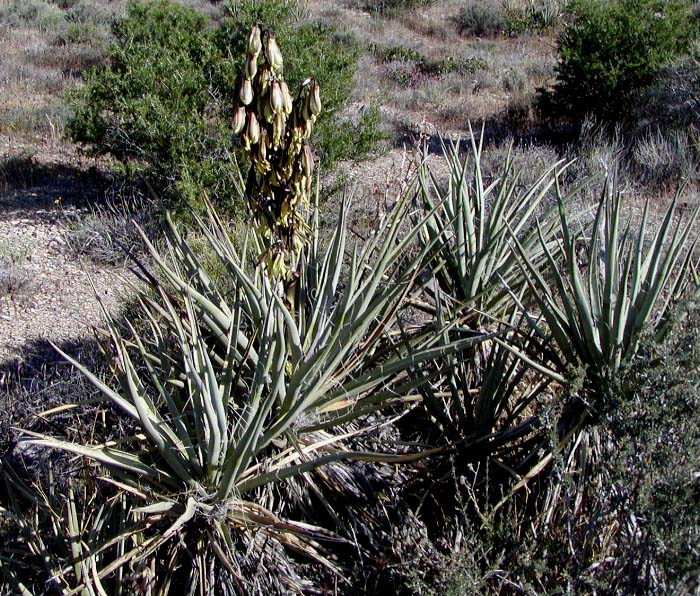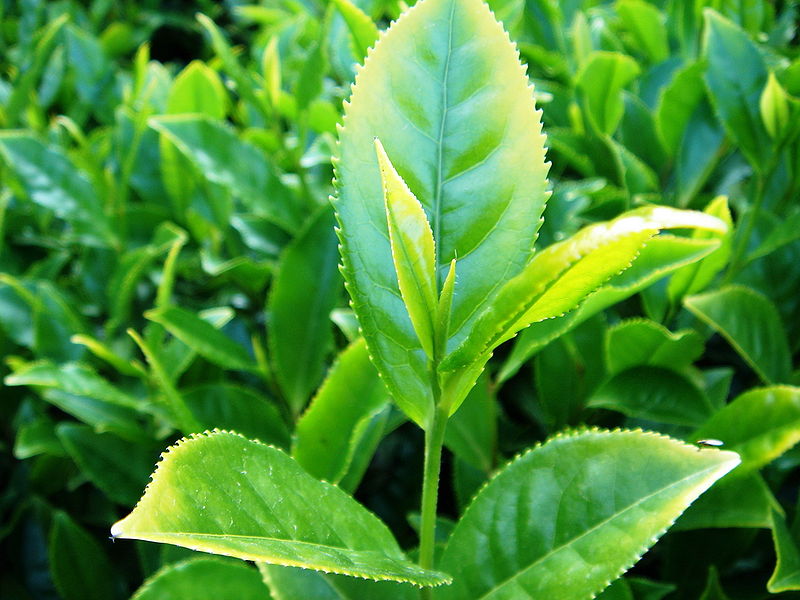
Unusual and Exotic Fruit and Nut Plant Seeds From Around the World
It is a native of the rainforests of Colombia, Ecuador and Panama. In its natural habitat, the Borojo Tree lives with 85% humidity in the air. The tree reaches 3-5 meters high.
The Borojo Tree is cultivated for its fruits rich in calcium. They have 7-12 cm in diameter and their color is green. The pulp of these fruits is acid and very dense. It is also brown. Each fruit contains hundreds of seeds. They are ready to consume when they fall off the branches. The uses of the Borojo fruits vary from juice, ice cream, capsules and jelly.
The trunk of the tree is small and sometimes separated in two or three smaller trunks. The trunk is grey-brown and harsh. The tree is an evergreen. The foliage is dark green and the leaves have a smooth texture.
Hardiness zones 10-11. The Borojo Tree can resist small periods of frost and even floods. It needs an average temperature of 28°C. Easily grown in warm greenhouses in cooler climates.
The tree enjoys moderate light. It requires good watering, don’t let the soil dry out. You may fertilize monthly with a balanced fertilizer.

TRZ081 Camellia Tea Plant ( Camellia sinensis )
This is the tea produced commercially around the world. The tender, young leaves are used in the process of tea production.
Can be grown in tubs inside, or in cool greenhouses, outdoors in warm climates. Prefers moist, well drained, humus rich,
slightly acidic ( 5.5-6.5 )soil. We recommend maintaining a 2-3 inch deep mulch of shredded bark or leaves around base of plant.
Hardy to zone 8, can be grown in zone 7 with protection. To make green tea, pick only the top 3 leaves from new growing tips, spread and dry in the shade for 6-8
hours, then in an open pot, heat ( simmer ) the leaves, stirring frequently for about an hour.
Click here for an informative site on growing and making your own tea.
For black tea, you must ferment the leaves. USDA Zones 8 to 11.
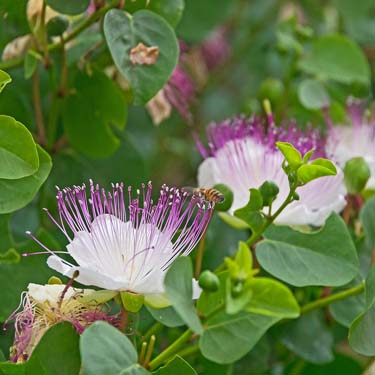
TWT091 Caper Bush ( Capparis spinosa inermis )
A perennial hardy to zone 9. Capers, a fixture of Mediterranean cuisine for 2000 years, are made from the unopened flower buds of this plant. The buds are pickled in strongly salted wine vinegar to develop their characteristic aromatic pungent flavour used to such advantage in French mayonnaise-based sauces, vinaigrette, and savoury butters. Capers tend to reduce oiliness in foods, and possess a natural affinity for garlic and lemon.
A slow growing shrub of dry, rocky areas of the Mediterranean and North Africa. For best results, freeze seeds in moist sand for 2 weeks, then sow and keep moist and dark until germination.
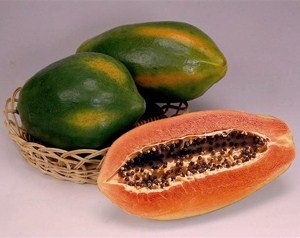
IP041 Red Lady Papaya ( Carica )
An early and productive fruiter, Red Lady is an excellent papaya for southern gardens or as a tropical container fruiting plant in the north. The dwarf tree starts to flower and set fruit during its second year when the plant reaches 4′ tall. It can fruit the first year, if grown in high light with an extended growing season. Red Lady is a self-fertile hybrid whose fruits often weigh 3-5 pounds. Two-pound fruits are more common for container grown plants. The oblong papaya is orange-red, sweet and juicy when ripe. Rich in vitamins A, C and other nutrients, it also contains papain, an enzyme that aids in the digestion of protein. Harvest the fruit when the skin yields slightly to the touch and changes from green to yellow. You will notice a sweet, delicious aroma when it is fully ripe. Green papayas are sometimes shredded and used in salads or stews. Grow in full sun and well-drained soil.
Hardy to Zone 10 and higher for outdoors.
Full sun, grows to 8′ in container, minimum temperature 50°F, blooms in spring. Germination about 75%.
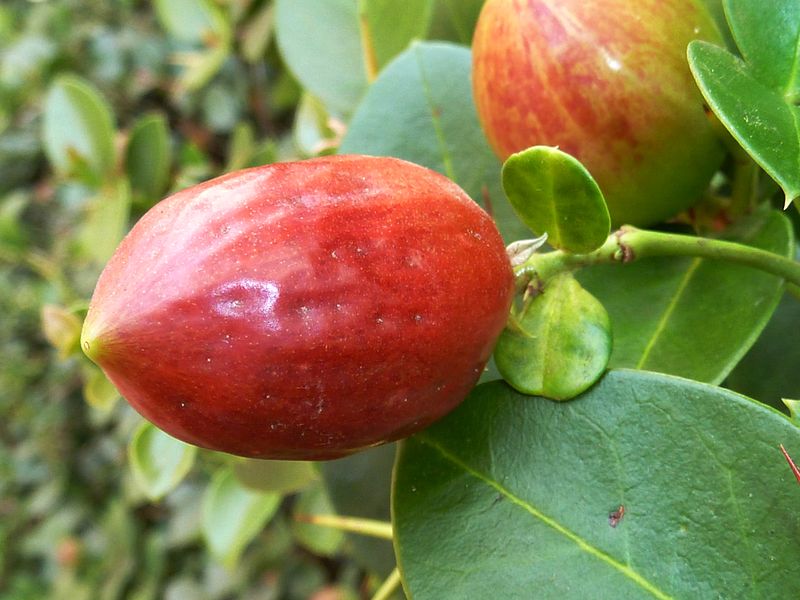
IP155 Natal Plum ( Carissa macrocarpa)
Natal Plum is a shrub native to South Africa, where it is commonly called the Large Num-Num. In Zulu, as well as in the Bantu tribes of Uganda, it is called amatungulu. In Afrikaans the fruit is called Noem-Noem.
It deals well with salt-laden winds, making it a good choice for coastal areas. It is commonly found in the coastal bush of the Eastern Cape and Natal. It produces shiny, deep green leaves and snowy white flowers whose perfumed scent intensifies at night. It is a spiny, evergreen shrub containing latex.
The flowers are about 2 inches across and sweetly fragrant, like orange blossoms, especially at night. The edible fruit is a pretty plum shaped red berry abut 2 inches long which tastes like sweet cranberries. Natal plum blooms almost all year long and most of the time both flowers and fruit are present. The fruit can be eaten out of hand or made into pies, jams, jellies, and sauces.
A traditional food plant in Africa, this little-known fruit has potential to improve nutrition, boost food security, foster rural development and support sustainable landcare.
Natal plum are among the best ocean front foundation, hedge, container and groundcover plants for tropical and subtropical regions. They are very popular in South Florida. Natal plums are often grown in containers on ocean front condominium balconies. Their thick leathery leaves are not torn by wind nor bothered by salt spray.
Zones 9-11 outdoors, but easily grown as a container plant and brought inside during winter.

FDR20 Sweet Pecan ( Carya illinoensis improved )
This seed is from grafted parent plants for improved nut
quality. Produceds large quantities of sweet, flavorful nuts.
Hardy for zones 5-9. A medium sized, fast growing pecan tree.
Seed requires 60-90 days cold moist stratification.
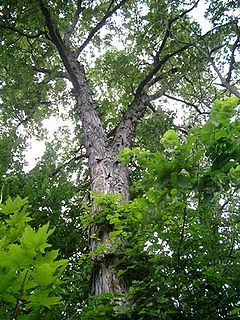
FDR11 Shagbark Hickory ( Carya ovata )
Shagbark hickory is probably the most distinctive of all
the hickories because of its loose-plated bark. Common
names include shellbark hickory, scalybark hickory,
shagbark, and upland hickory. Shagbark hickory is evenly
distributed throughout the Eastern States and, together
with pignut hickory, furnishes the bulk of the commercial
hickory. The tough resilient properties of the wood make it
suitable for products subject to impact and stress. The
sweet nuts, once a staple food for American Indians,
provide food for wildlife. Zones 5-8A.
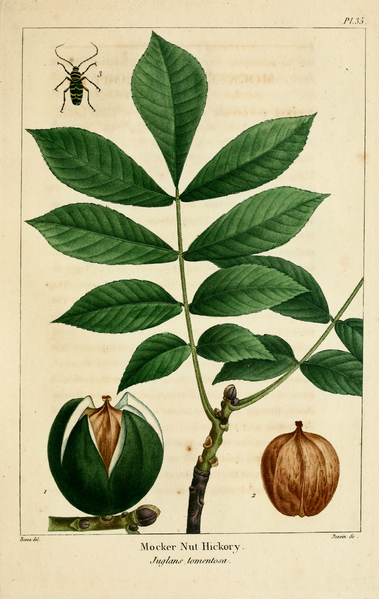
FDR51 Mockernut Hickory ( Carya tomentosa )
A large nut tree growing to 60-80 feet tall and hardy for zones 4-9. Mockernut hickory is a medium to large, deciduous tree with a straight trunk and rounded crown that typically grows 60-80′ (less frequently to 100′) tall. It is primarily native to hillsides and ridges in somewhat dry soils. It grows throughout the eastern and central U. S., with concentrations of tall trees in the Ohio River valley and Mississippi River valley. In Missouri, it is found in dry upland woods, ridges and slopes throughout the State, except it is not present in the southeastern lowlands and northwestern corner.
Compound, odd-pinnate, dark yellowish-green leaves (each to 6-12″ long) have 5-7, toothed, ovate-lanceolate leaflets. Leaflets grow 3-6″ long. Leaflet undersides are downy and glandular. Rachis and petiole are pubescent. Leaflets are aromatic when cut or bruised. Leaves turn an attractive yellow in fall. Thin dark gray bark develops furrows and flattened ridging as it matures. Non-showy, monoecious, yellowish-green flowers bloom in April-May, with the male flowers in drooping catkins (to 6″ long) and the female flowers on short spikes.
Female flowers give way to fruits (rounded nuts), but only after the tree reaches about 25 years old. Each nut is encased in a thick, four-grooved husk which splits open in fall when ripe. Nuts are edible for humans but can be very difficult to extract from the husks, hence the common name of mockernut.
Nuts are eaten by a variety of mammals including squirrels, chipmunks, rabbits, raccoons and black bears. Light colored sap wood of this tree gives rise to a sometimes used common name of white hickory. Genus name is a Greek name for walnut. Specific epithet means with short hairs in reference to the leaflet undersides.
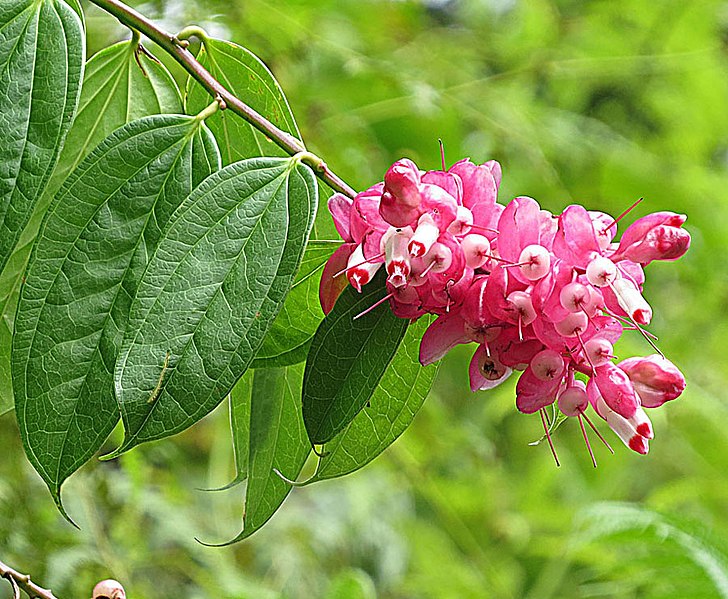
LET250 Mountain Grape ( Cavendishia bracteata )
A wonderful blueberry relative that is pretty much unknown in the gardening community. This is a very showy plant that puts out gorgeous clusters of pink, bottle-shaped blooms that are tipped with white and bloom pretty much througout the year.
From the mountainous areas from Mexico to South America, it’s usually found growing as an epiphyte on trees, but it adapts well to soil. It forms a large, caudex-like root crown, and arching, woody branches that grow 10 feet long, unless pruned shorter. Its big, evergreen leaves are very attractive, they are thick, glossy and about 6 inches long. Each flower cluster has dense rows of glossy, inch-long blooms, and are accented by large, flaring bracts. These large floral displays are pollinated by hummingbirds. The plant makes attractive, edible fruit which looks like purple blueberries. They are lightly sweet & tart, and are reportedly high in antioxidants.
It is best grown in mild climates that do not get too hot, and does not get lower than the upper 20’s during winter.

D2209 Chinese Hackberry ( Celtis Sinensis )
A hardy and easy to grow plant. Tolerates drought; any soil;
gusty winds; smog; sun or shade, but does not like heavy fog.
Makes an attractive, low-maintenance street tree. Deep,
non-invasive roots rarely cause sidewalk problems. Disease and
pest resistant. Berries attract birds. Tree grows to10m in
cultivation. Small green flowers are borne in Spring followed
by small, sweet, edible fruit which are a dark-orange ripening
to red-brown.
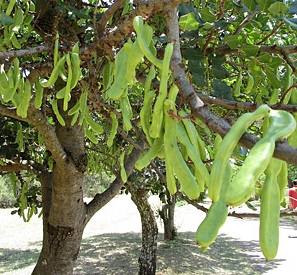
D2249 Carob Tree ( Ceratonia )
Ceratonia siliqua, commonly known as the carob tree, St John’s-bread, or locust bean is a species of flowering evergreen shrub or tree in the pea family, Fabaceae.
It is widely cultivated for its edible pods, and as an ornamental tree in gardens. The ripe, dried pod is often ground to carob powder, which is used to replace cocoa powder. Carob bars, an alternative to chocolate bars, are often available in health-food stores.
Carob consumed by humans is the dried (and sometimes roasted) pod. The pod consists of two main parts: the pulp accounts for 90% and the seeds for 10% of the pod weight.
Carob is mildly sweet and is used in powdered, chip or syrup form as an ingredient in cakes and cookies, and as a substitute for chocolate. Carob bars are widely available in health food stores. A traditional sweet, eaten during Lent and Good Friday, is also made from carob pods in Malta. Dried carob fruit is traditionally eaten on the Jewish holiday of Tu Bishvat.
While chocolate contains levels of theobromine which are toxic to some mammals, carob contains significantly less caffeine and theobromine, and is therefore used to make chocolate-flavored treats for dogs.
Carob pod meal is used as an energy-rich feed for livestock, particularly for ruminants, though its high tannin content may limit its use. Carob pods were mainly used as animal fodder in the Maltese Islands, apart from times of famine or war when they formed part of the diet of many Maltese. In the Iberian Peninsula, carob pods were used to feed donkeys.
The carob tree is native to the Mediterranean region, including Southern Europe, Northern Africa, the larger Mediterranean islands; to the Levant and Middle-East of Western Asia into Iran; and to the Canary Islands and Macaronesia.
Carob trees may be grown in USDA zones 9-11.
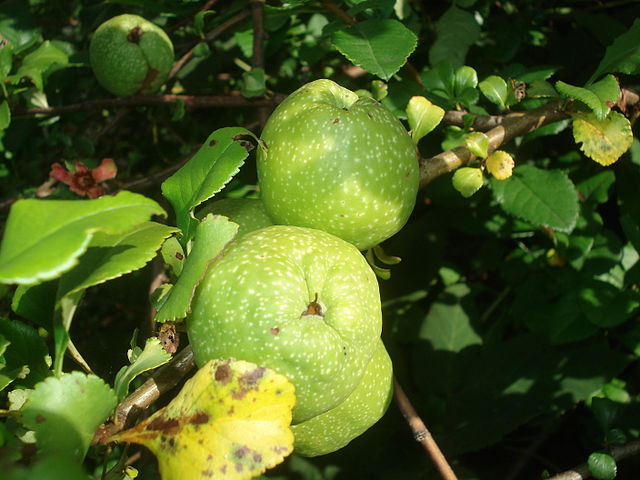
NW56 Japanese Flowering Quince ( Chaenomeles japonica )
A plant with many uses. It has showy fragrant flowers, is easy to grow, very adaptable, can be used as a bonsai, it attracts butterflies, has edible fruit, can be used as espalier, hedge, or screen/windbreak, and it is drought and wind tolerant
Very nice for a shrub border, hedge, screen, barrier or espaliered to wall. Cut branches with swollen flower buds may be forced indoors, making a welcomed winter flower arrangement.
Japanese Flowering Quince is a dense, broad-rounded, deciduous fruiting shrub or small tree. It typically grows to 5 to 10 feet tall and as wide. The leaves are finely-toothed, oval to oblong, glossy dark green to 3.5 inches long. Leaves may emerge in spring with a bronzy cast. 2 inch, scarlet to red and sometimes pink or white five-petaled flowers bloom before the leaves fully unfold in an often showy early spring bloom.
Flowers are followed by hard, dot-speckled, yellowish-greenapple shaped fruits (2.5 inch Quinces) that may acquire red tinges as they mature in autumn. The fruit is called Karin in Japanese and is very hard and astringent and very unpleasant to eat raw, though they do soften and become less astringent after frost (when they are said to be “bletted”), much like persimmons.
They are suitable for making liqueurs, as well as marmalade and preserves, as they contain more pectin than apples and true quinces. The fruit also contain more vitamin C than lemons.
Zones 5-9.
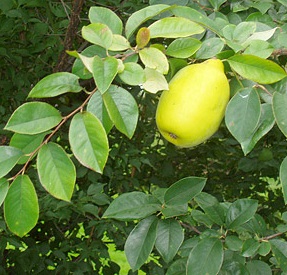
TRZ101 Chinese Quince ( Chaenomeles sinensis )
An attractive semi-evergreen or deciduous tree that can reach to 10 to 20 feet tall. It grows a dense crown with spreading branches that hold smallish leaves and pink flowers.
Flowers are followed by huge, oval fruits (quinces to 5-5″ long) which ripen in fall with a sweetly fragrant aroma. Fruits are edible off the tree or may be used in jams and syrups. Flakey, sycamore-like bark exfoliates into an attractive patchwork of gray, green and brown on the fluted mature trunks of this tree.
The fruits are very aromatic and are placed in a bowl to impart a delightful spicy scent to a room. The wood is hard, dark red and used for picture frames.
The fruit is antitussive, it contains several medically active constituents including organic acids plus the flavonoids rutin and quercetin. It is used in Korea to treat asthma, the common cold, sore throats, mastitis and tuberculosis.
Zones 6-9.
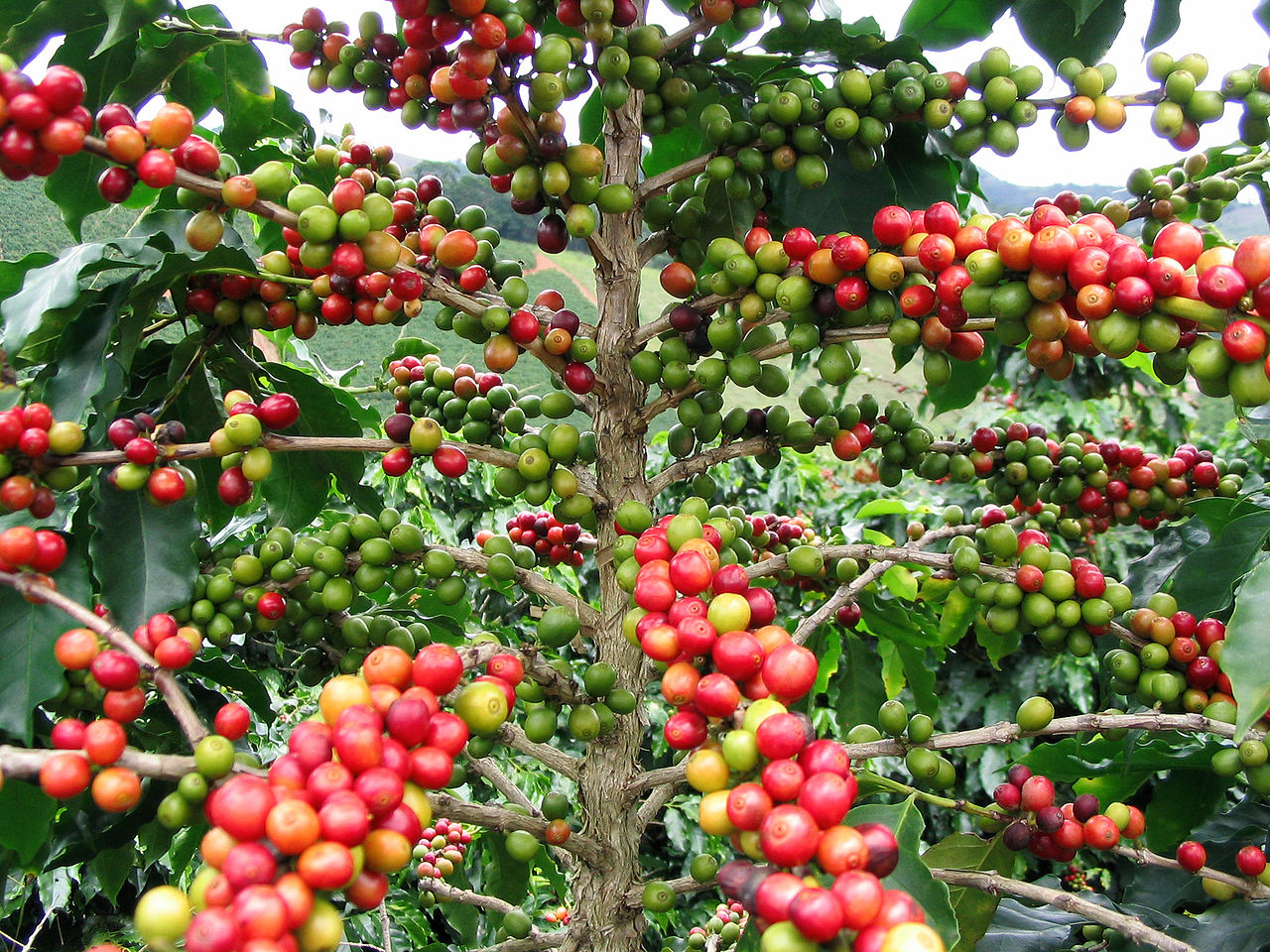
D4503 Coffee Plant ( Coffea Arabica )
Coffee can be grown outdoors in some parts of the US, but is often grown in pots. The world’s most important trade crop also makes a wonderful
house plant. The plants have dark shiny-green leaves and white
fragrant flowers. A very ornamental plant. Very unique.
Considered to be among the easiest and hardiest of houseplants, coffee plant is great for both experienced and beginner gardeners. Not only is coffee plant care easy, but the plant itself is lovely and makes a wonderful addition to the home. Coffee plants prefer bright, but indirect, light. This means that they should be placed near a window but not directly in the window itself. They also cannot take temperatures below freezing and will not do well in temperatures that stay consistently below 65 degrees. Keep them away from drafts in the winter. When growing coffee plants, the soil needs to stay moist, but not soaking wet.
Also, make sure that both the soil and the pot your coffee plant is growing in has good drainage. The humidity around the plant will need to stay high as well. Setting your coffee plant on a water-filled pebble tray will help with humidity. Like many houseplants, a coffee plant will need less water in the winter than in the summer.
Plant coffee plants in a rich, peat-based potting soil with excellent drainage. Coffee plants prefer acidic soil, so if your plant is not thriving add organic matter such as sphagnum peat moss to increase soil pH. Coffee plants can grow in soil with a pH range of 4 to 7 but the ideal pH range is closer to 6 to 6.5.

Z2819 Dwarf Catura Coffee ( Coffee arabica )
This is the gourmet cafe coffee variety. Grows only 24-30″ tall and a mature plant is loaded with beans. Can be grown inside as a houseplant, needs tropical warmth outside.
Catura is a natural mutation of the Bourbon variety. It was discovered on a plantation in the state of Minas Gerais in Brazil sometime between 1915 and 1918. Caturra has a single-gene mutation that causes the plant to grow smaller (called dwarfism). The coffees’ taste tends to have a bright acidity with potentially less clarity than Bourbon.
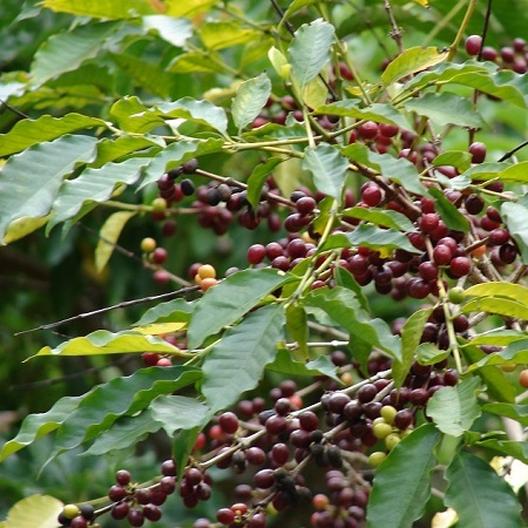
1A136 Kona Coffee ( Coffee Arabica )
The Kona is the very popular coffee of Hawaii. Its a heavy bearing variety with excellent quality. Normally it begins to produce in 4 years. One producing tree can provide 1 lb. of coffee. Can be grown in bright light indoors, outside in zone 10 and higher.

1A139 Coffea Racemosa ( Coffee Racemosa )
Another commercial Coffee similar to Robusta but with a more branching, compact habit with a mature height of 4′. A very prolific coffee of excellent quality. Favored by most
growers.
A Racemosa coffee plant is about the third of the size of a Robusta coffee plant and it does not bear near as many coffee beans. But the really big thing about Racemosa coffee, is that it’s naturally so low in caffeine that it is close to being naturally caffeine-free and can be used in place of decaf coffee.
It also makes a great houseplant for cooler zones ( you probably need zone 9 to grow it outside ).
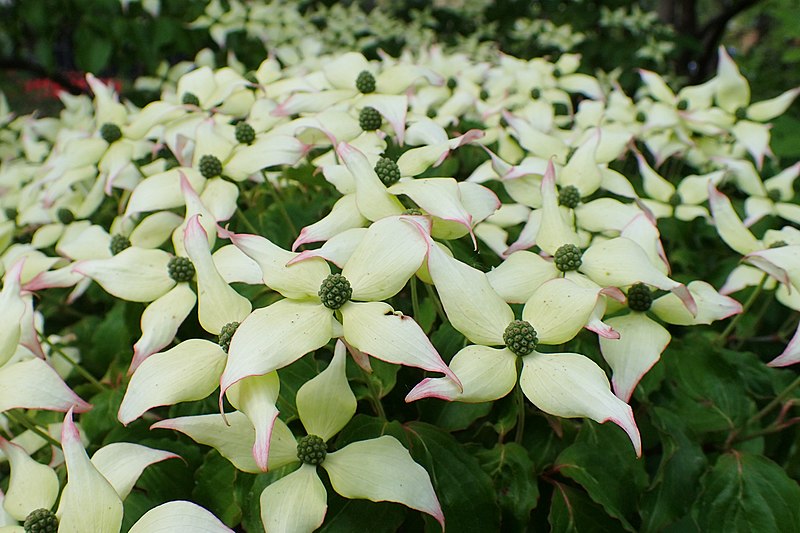
JF976 Korean Kousa Dogwood ( Cornus kousa )
A wonderful dogwood with so many uses and benefits, it has beautiful spring blossoms, great fall color, edible fruit that is showy and ornamental, and attractive bark. It can be grown as a lawn specimen, as a patio plant or sidewalk plant.
Kousa dogwood is an excellent small specimen tree for small lawns. Two outstanding characteristics are the four-petaled, white flowers that appear above the foliage in June and reddish-purple fall color. In the Midwest, this is a hardier substitute for the acid-loving flowering dogwood. The shallow root system will benefit with a layer of mulch to maintain a cool root environment.
Kousa Dogwoods are very showy for a long period of time as the flower bracts are showy longer than most flowers. They’ll give you up to a month of display. The flowers precede the red fruit, which looks like a raspberry. Some people make jellies, jams and wine from the round red berries, or, leave the red colored fruit for birds! They’ll be happy to snap them up for you without any fuss or muss.
best suited for zones 5-8.
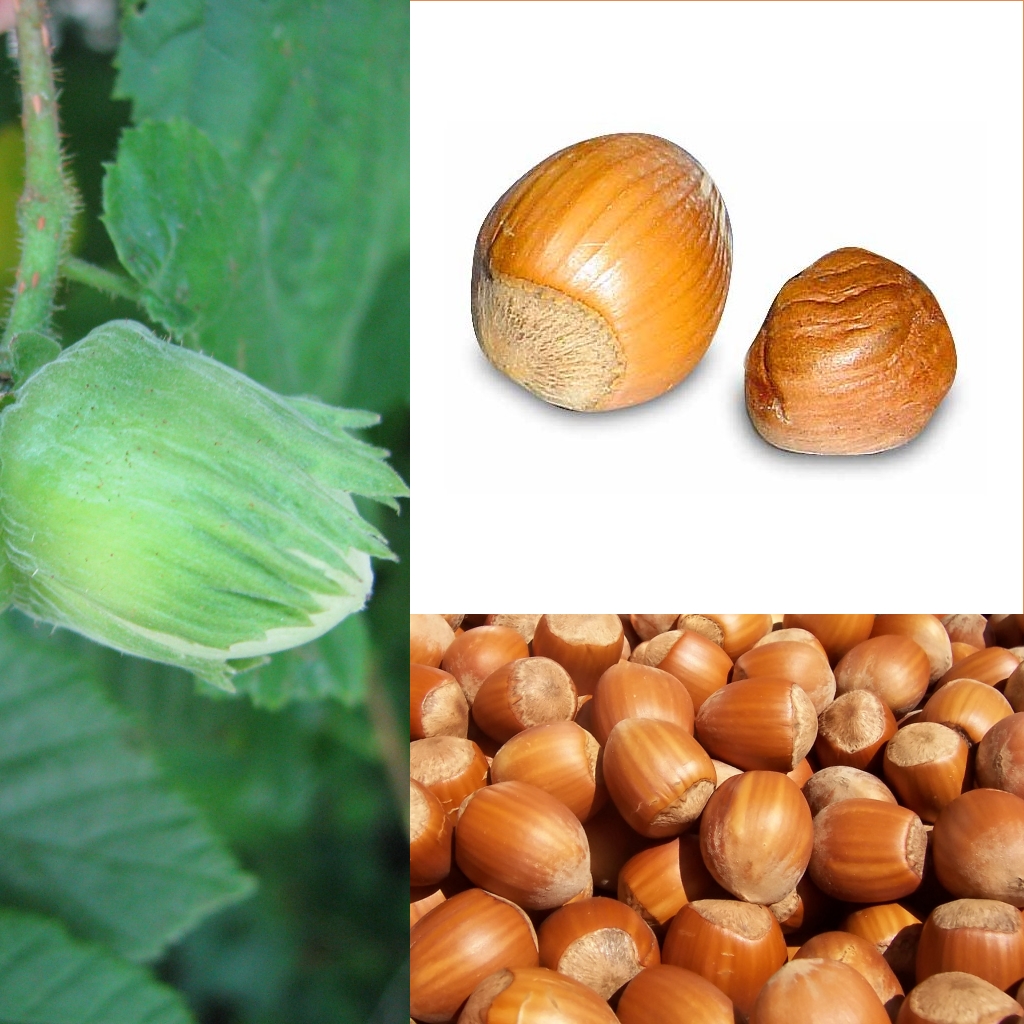
FDR15 American Filbert ( Corylus americana )
The tasty nuts are highly prized by cooks for their easy-to-crack shells and small, sweet kernel. Squirrels love them as well, most likely for the same reasons. Hazelnut hedges can be used as windbreaks, visual screens, and to attract wildlife.
American hazelnut is a thicket-forming native shrub, excellent for naturalizing, woodland gardens and shade areas. Showy male flowers (catkins) add early spring interest, dark green leaves turn a beautiful kaleidoscope of colors in the fall. The nuts mature from September to October, attracting seed-eating birds, such as blue jays and woodpeckers.
Also known as American Hazelnut. Good for Zones 4-9. Multi stemmed, branching shrub to about 10 ft. tall. Attractive,
pointed, toothed, dark green leaves. Bears loads of edible nuts in fall. Native to Eastern
US.
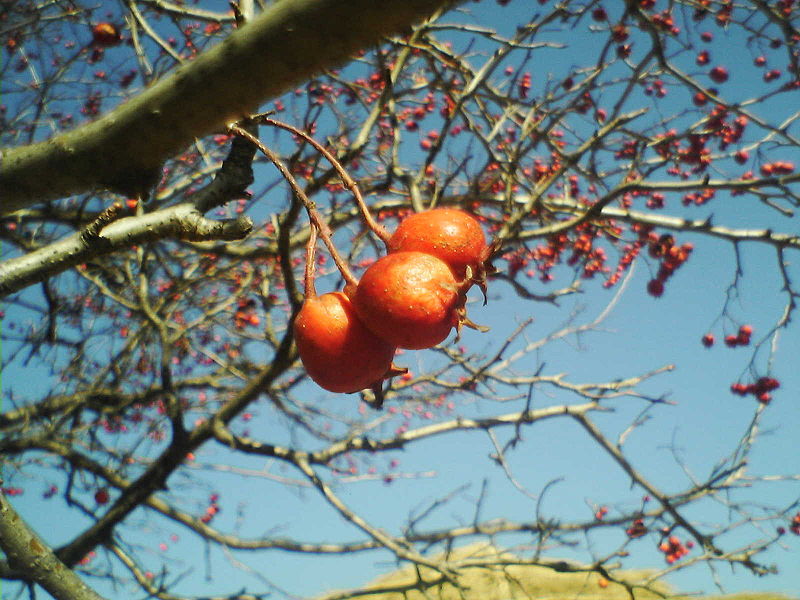
TRZ060 Chinese Hawthorn ( Crataegus pinnatifida )
A large shrub to small tree growing up to 25 feet, but often smaller.
A pleasant flavor. The orange fruit has a mealy texture with an acid taste and a slight bitterness but is fairly nice raw. The fruit can be used in making pies, preserves, etc, and can also be dried for later use. The fruit is about 1/2 inch in diameter. There are up to five fairly large seeds in the centre of the fruit, these often stick together and so the effect is of eating a cherry-like fruit with a single seed.
Zones 5-9.
Note: These seeds need to be cold statified before
sowing.
We recommend using the Seedman’s Cold Stratification
Kits for cold stratification.
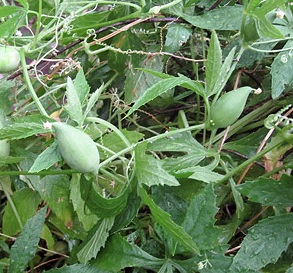
IP122 Caigua Exploding Cucumber ( Cyclanthera pedata )
This is one of the most interesting plants we have found. It is a climbing member of the cucumber family that can be used as a vegetable in salads, or steamed, it has a nice sweet flavor. It is also an herbal plant, the fruit has anti-inflammatory, weight reducing ( it is often sold in capsule form as a natural weight loss product ), lipid-absorbing, cholesterol and blood sugar regulating affects.
Can easily be grown in the garden, on a fence or trellis. It is an annual plant. One of the most interesting aspects of the plants is that when ripe, the fruits become spring-loaded missile devices, splitting and turning themselves inside-out to launch their seeds up to 5-6 feet away into the garden. This is quite the conversation plant.
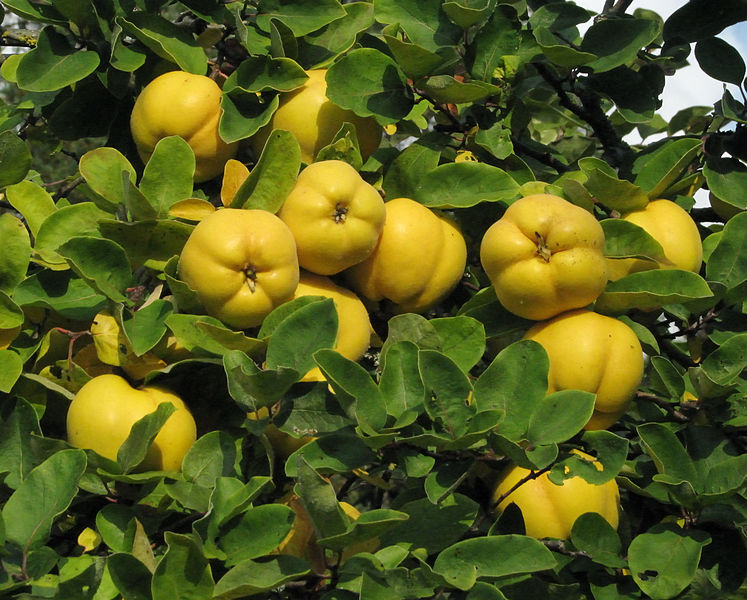
TRZ120 Quince ( Cydonia oblonga )
Edible quince trees produce fruits that can be used mostly for cooking, pies, jelly or some can even be eaten fresh. The fruit looks like an irregularly shaped pear or apple with a very tough flesh. But after being cut, quince has a lingering wonderful fragrance and becomes sweeter and softer after cooking. Quince trees are naturally small with very showy blossoms. Quinces are self-fruitful.
While some quince can be eaten raw, its true beauty is in the delicious fragrance and rosy-red color unlocked by poaching or cooking them. Quince jelly is a natural, because of the natural supplies of pectin in quinces. Quince is also delicious added to apple or pear tarts and pastries and quince paste is an elegant accompanient to cheeses such as manchego.
The fruit ripens in mid-fall and contain high levels of pectin, so are ideal for using in jams and preserves. The trees are attractive while in bloom and grow to about 15′ tall at maturity. Hardy in USDA zones 4-9.
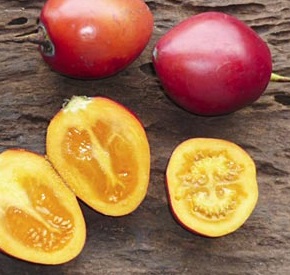
D2212 Tree Tomato ( Cyphomandra Betacea )
The tree tomato is an unusual large shrub native to Peru. It is
a tropical plant that only does well outside in zone 10 or
higher, but is an excellent container plant as it has a very
shallow root system and is easy to container grow for landscape
purposes.
The trees grow ten to twelve feet in height and may be
single-or multiple-stemmed depending on how they are trained.
The large, somewhat oval leaves may be six to twelve inches
long, and are softly pubescent. The small pinkish fragrant
flowers are produced in the spring and early summer and the
fruits mature during the fall and following winter.
Mature fruits are about the size of a normal chicken egg and
also about the same shape. Fruits, at maturity, can be orange,
red or purple, depending on the variety. Internally, they
somewhat resemble a tomato. Like tomatoes, they can be be eaten
as a vegetable and used in sauces, soups or other ways. The
most popular way of consuming the tree tomato is as a conserve.
It can be made into jams and jellies also, but unlike regular
tomatoes, when being cooked the seeds and skin of the tree
tomato should be removed.
The fruits, although they somewhat resemble tomatoes, do not
have a tomato taste, but are pleasant for most people.
FB101 Date Plum ( Diospyros lotus )
A type of persimmon tree, produces a small fruit with a taste similar to both dates and plums. Known by the ancient Greeks as the fruit of the gods, the date plum is renowned for its sweet taste.
It is a decidious tree that is native to Middle East and South Asia, especially from China and Japan. This tree can reach up to 90 ft (30 m) tall in warm areas, but will generally be smaller. (Up to about 30 ft -10 m- tall) it bears edible small fruits in autumn.
The leaves of the date plum are decidious, and are about up to 4-5 in (10 – 12.5 cm) long.
Flowers – Flowers are small and yellow-green, and are dioecious. At least both a male and female plant will be required to get viable seeds. A pack of 10 seeds will usually produce both male and female plants, can be pollinated by other persimmons.
The date plum is a close relative to the persimon. However, the date plum is a smaller fruit, as it is about 0.75 in (2 cm) wide. It is a globose yellow fruit that turns purple-brown when fully ripe. Like the persimon, the date plum looses its astringency when fully ripe. The flesh is then very soft and rich in flavour.
This tree is frost hardy down to -15°F (-25°C) and less. It can easily be grown in USDA zones 5 and warmer. The date plum needs a fairly well-drained and deep ground.
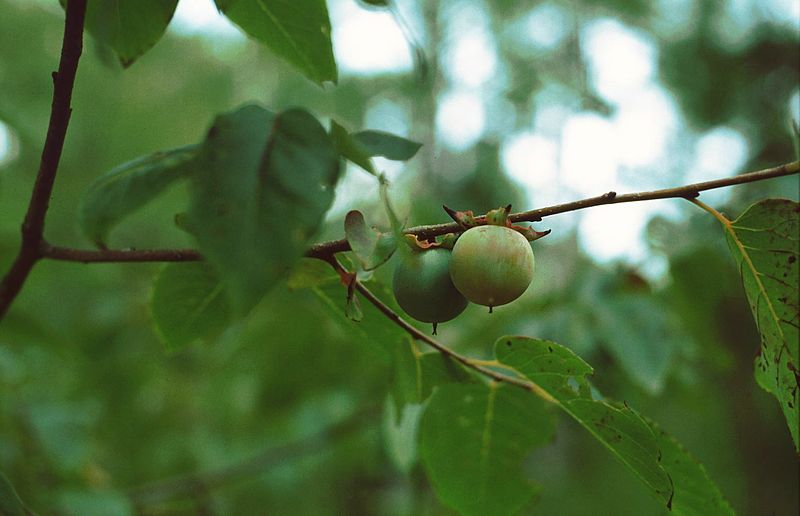
D2217 American Persimmon ( Diospyros
virginiana )
The persimmon is a slow-growing deciduous tree, rarely exceeding 50 feet in height. The leaves are generally elliptic, 4-6 inches long, dark green on top and pale green underneath.
The bark on older trunks is black and broken up into distinctive, regular square blocks. The female flowers develop into showy orange fruits, up to 2 inches in diameter, that are very astringent during maturation, but deliciously sweet when fully ripe.
Persimmon is native to eastern North America from New England, west to Kansas, and south to Texas and Florida. It is one of the most widely-adapted of trees, growing naturally in bottomland swamps, along stream banks, in upland forests, in fields, piney woods, and even dry scrub lands.
Prefers full sun, but also does well in partial sun. Highly adaptable, tolerates drought and even brief flooding. Hardiness: USDA Zones 6-10.
Wild persimmons and their seedlings vary greatly in fruit quality and size. Plant persimmon trees in the natural area of your landscape where their fruit will can be shared with wildlife as well as children.
When you gently shake a persimmon tree, the ripe fruits fall to the ground. If you have to pull the fruit off the tree, it will surely pucker your mouth inside out! Ripe persimmons are delicious out of hand, and can be made into puddings and cakes. Frozen, they satisfy like ice cream, while dried persimmons are like dates. Persimmon wood is prized for its beauty and extreme density, and used for golf club heads and pool cues.
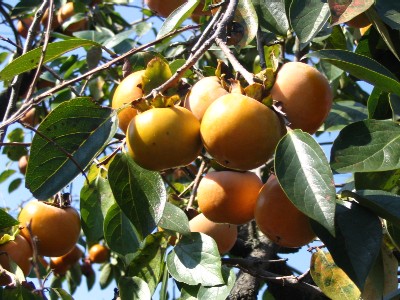
SO456 Japanese Persimmon ( Diospyros kaki )
A very popular fruit tree from the Far East that has gained
popularity in the US. Easy to grow from seeds. Can be raised
inside in tubs in the north and outside in mild climates. The
fruits are large, up to 3″ across and sweet.
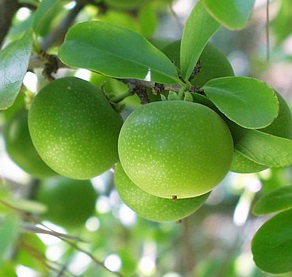
3649 Kei Apple ( Dovyalis caffra )
Dovyalis caffra or Kei Apple is an evergreen shrub to small tree native to South Africa. In nature, the plants will reach up to 20 feet in height with a spread of around 8-10 feet wide.
It is a very dense shrub with very stiff, sharp spines. Spines will reach up to 3 inches long. The obovate, glossy leaves are up to 2 inches long.
Leaves are usually clustered at the base of spines. Plants are moderately fast growers and one can expect them to produce fruit in 5-6 years from seed. They are very drought resistant and their size is easily controlled with container size and selective pruning.
The plants are hardy in USDA zones 9-11.
The very small greenish yellow flowers are followed by 1 inch yellow fruit. The mature fruits taste somewhat like an apricot.
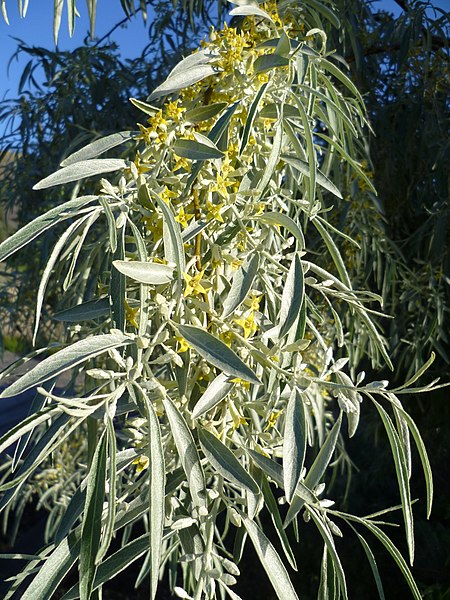
D2219 Russian Olive ( Elaegnus Angustifolia )
Zone 6-9. A very fragrant plant when in bloom, with a rich honey like fragrance. Russian-olives are non-native, deciduous shrubs or
small trees that grow to 20 feet tall. It has yellow flowers
and dry yellow mealy fruits. Silver scales occur on the
underside of the leaves. The twigs of Russian-olive are
typically covered with thorns. These shrubs begin to flower and
fruit annually after 3 years. An individual plant can produce 8
pounds of fruit each year. The leaves are covered with small
scales which give the foliage a distinctive silvery appearance.
The fruit is berry-like, and is silvery when first formed but
turns brown at maturity.
Although its fruits are used in drinks and to make preserves,
it is more sought after for its white shoots and
silver undersides of leaves which give them an ornamental
appeal.

TRZ029 Japanese Loquat ( Eriobotrya japonica )
This beautiful little evergreen tree has everything going for it: beautiful foliage, fragrant flowers, delicious fruit and it is easy to grow!
The loquat grows to about 20 ft assuming a rounded form with upward pointing branches. The large leaves are about 10 inches long and are a deeply textured dark green on top, while the bottom surface is light green and slightly fuzzy.
New foliage on some specimens is an attractive rusty red. Deliciously scented, furry looking white flowers grow in terminal clusters in late fall. They are followed by small, edible yellow fruits in spring.
Loquats are native to China and Japan. They are popularly grown as ornamentals in the southeastern and western parts of the United States. In frost-free areas, they are also grown for their delicious fruit.
Use loquat as a specimen plant and as a shade tree for the patio or terrace. It’s easy to grow, practically maintenance free, and does well in containers. It can be espaliered.
Loquat fruit is a tasty treat that can be enjoyed fresh, dried or in jams and preserves.
USDA Zones 7 – 10. Fruit and flowers are destroyed by low temperatures at about 26 to 28°F. In Florida, the foliage will withstand temperatures to 15°F for short periods of time.
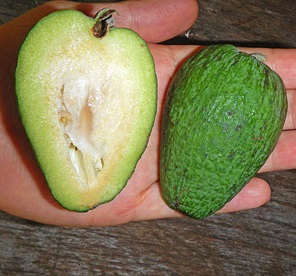
D2925 Pineapple Guava ( Feijoa )
Originally native to southeastern Brazil and northernmost Argentina, this shrub or small tree is now widely cultivated around the world for its edible fruits, as well as for its ornamental qualities. Acca sellowiana grows to about 12-15 feet tall and forms a dense, rounded crown of small leaves that are grayish furry underneath.
The pinkish flowers have prominent red stamens and are followed by plum-sized, yellowish green fruits that are amazingly delicious, highly aromatic, lightly acidic and remind of pineapple and strawberries. They are eaten raw or used in jams, juices or sauces.
Hardy to zone 8.
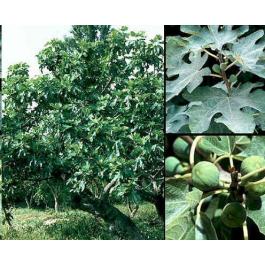
D9915 Common Fig ( Ficus carica )
Ficus belongs to the Mulberry Family. The Common Fig is native to the eastern Mediterranean and western Asia region where it grows wild and has been in cultivation for centuries. The cultivated Fig forms a shrub or low-spreading tree.
The fig is a picturesque tropical looking tree or shrub with a dramatic spreading habit. The breadth is often wider than the height of 15 to 30 ft (4.6-9 m) with equal spread. This deciduous, low-branching tree is usually single trunked, with pale, silvery gray smooth bark. In colder regions, figs are grown as bushes with multiple stems and branches close to the ground that are laid down and buried before winter. The Ficus makes an especially attractive specimen in the landscape. Plant one on an expanse of lawn, where it’s graceful spreading shape and smooth twisting branches command attention in all seasons.
The alternate, long petioled, dark green leaves are broad-ovate to nearly orbicular in outline and may become 20cm(10 in) long and 10-20 cm (4-10 in) wide with 3-5 lobes. The upper surface is thick and ribbed while the underneath is finely haired .The leaves texture is rough and they can irritate skin.
The Genus Ficus is unique for bearing its flowers inside a nearly closed receptacle, or branch, which ripens into a fleshy fruit called a fig. The small flowers are produced twice in the season. The first ones (the breba crop) are produced near the ends of the shoots of the preceding flush of growth, whereas the second crop (the main crop) is produced in the axils of the leaves on the new growth.
The mature fruit is pear shaped and variable in size and range in color from a greenish-yellow to purple. The edible fruit is a hollow succulent receptacle with many ovaries on the inner surface, which may or may not produce seeds, depending on the variety.
Figs usually begin bearing fruit within two years and may bear twice per year. Figs grow nicely and will bear fruit when grown in containers where they can be artfully pruned to create a living sculpture to decorate deck or patio. This is convenient for two reasons: cold climate growers can move their figs indoors in winter and the plants can be removed from the patio when the fruit begins to (over)ripen. The edible fruit are extremely attractive to birds.
Hardy for zones 7-10. Note that with winter protection, it can be grown as far north as Zone 5. The Ficus Carica likes reflected sun, full sun, or part shade. Fig trees are tolerant of poorly drained soils and grow well in relatively infertile soils. When fully dormant, fig trees can tolerate temperatures as low as 10 to 15°F (-9°C). Even if frozen, figs often will restart from the roots and produce a crop the following summer. They are drought tolerant, once established. Figs responds well to pruning and can be espaliered or pruned heavily in the dormant season for size control and to increase the main crop. Water the tree every month or two while it is growing, and once or twice per year when fully grown. They grow much better with a monthly fertilizing program and deep watering twice a month in summer.
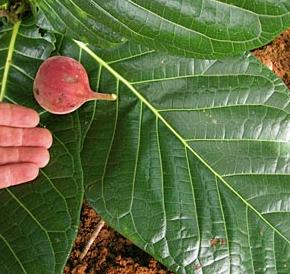
SF302 New Caledonia Fig ( Ficus habrophylla )
This fig from New Caledonia is eaten by the Kanak people and popular for making into pies. The very large leaves of this tree are dark green and showy, making it an absolutely gorgeous ornamental as well. It grows well in pots when young. Grow as an inside plant when young, or outside in zones 8-11.
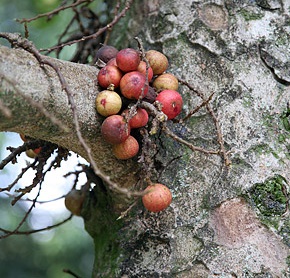
3399 Cluster Fig Tree ( Ficus racemosa )
An evergreen tropical fig that can be grown in large tubs.
Impressive large Ficus species which can easy be recognized by the myriad of fruits that are hanging from its branches almost the whole year round.
Popularly known as the Cluster Fig Tree or Goolar (Gular) Fig, this is native to Australasia, South-East Asia and the Indian Subcontinent. it is unusual in that its figs grow on or close to the tree trunk.In India the tree and its fruit are called gular in the north and atti in the south.The fruits are a favorite staple of the common Indian macaque. In Vietnam, it is called sung.
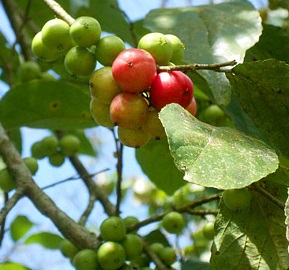
D9923 Lovi-Lovi ( Flacourtia inermis )
A beautiful, bushy small tree with glossy green leaves that are reddish when young and cherry-sized, bright red, edible and acidic fruits throughout much of the year that are eaten fresh or made into jellies or jams. Flacourtia inermis is best suited to tropical climates in USDA Zones 10 and above.
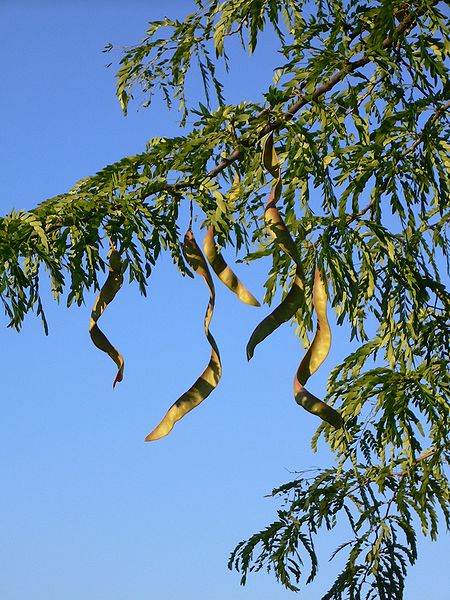
D2220 Honey Locusts ( Gleditsia )
This tree is cultivated for its golden fern-like foliage. The
small, greenish-yellow flowers bloom in May and June and are
fragrant. The fruit are actually 7″ to 18″ long, twisted,
flattened pods, approximately 1″ wide and strap-like, color
changes from green to dark brown. The pulp is sweet and thus
the name. The pods are often fermented to make beer or to feed
to livestock. Beware, lots of thorns! Hardy to zone 4.
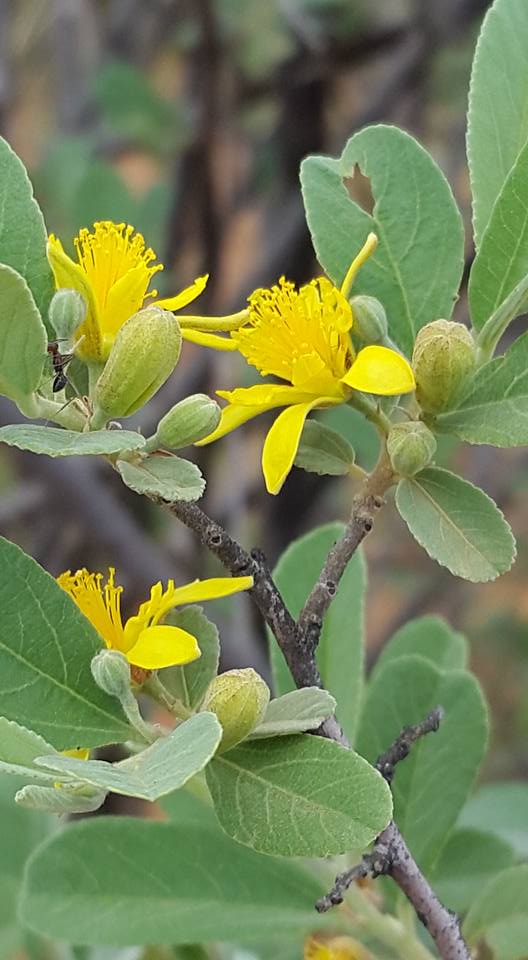
SF349 Brandybush ( Grewia flava )
The Brandybush is a shrub found in the Kalahari. The tasteful, flesh rich fruits are gathered by the San people from February to August and are eaten in large quantities. They are also mashed, soaked and eaten as a porridge.
In the flowering season, the beautiful sweet-scented star-shaped yellow flowers can be found growing on the angles where the leaves grow on the branches. These in turn make way for the berry-like fruit that starts showing from December to April. The berry fruit is reddish brown in colour when ripe and ready to eat, is sweetish in flavour and has a fairly high sugar content.
A recent seed addition from Africa, we do not yet know zone requirements for this plant, so grow at your own risk!
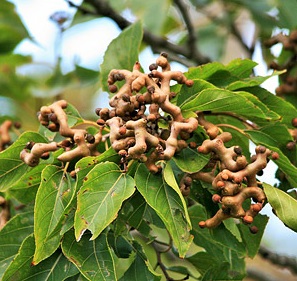
IP301 Japanese Rasin Tree ( Hovenia dulcis )
Japanese Raisin tree can reach 40 to 50 feet in height but is
most often seen at 30 to 35 feet with an open, upright, oval
silhouette. Unfortunately it is a little too big for planting
beneath most power lines. The tree usually maintains a fairly
good central leader with small-diameter main branches. The four
to six-inch-long, glossy green leaves are particularly striking
and create light shade below the trees but they show no
appreciable color change in autumn, dropping while they are
still green. In early summer, the branch-tips of the trees are
festooned with small, two to three-inch-long cymes of
sweetly-fragrant, greenish-white flowers which are quite
attractive to insects. These blooms are followed by the
production of small, fleshy, brown drupes which ripen to bright
red and have a flavor similar to a sweet raisin, giving the
tree its common name. Hardy for zones 6A
through 10A.

2903 Hops ( Humulus lupulus )
Hops produce rich, heavily scented, green-golden fruit that is harvested in autumn. The flowers of Humulus lupulus contain the chemicals myrcene, myrcenol, resin, linalool, humulene and tannins, all used extensively in the pharmaceutical industy. Also, another common usage is flavoring for the beer industry.
Hops seeds can be slow to germinate. Use a process called “cold scarification” to encourage hop seed germination. A good method is to put seeds in an equal amount of moist sand and refrigerate from one to three months at about 41 degrees F. After that, plant the seeds at 68 degrees F. for one to two months. If the hops seeds have not germinated, put them back in the refrigerator and repeat the cycle.
Decorative fast
growing vine, excellent for porches and screens.
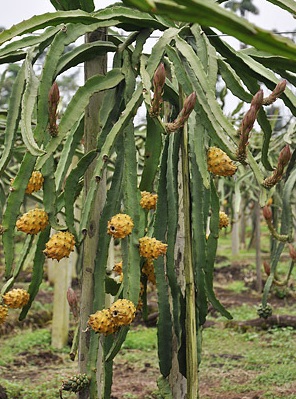
D9917 Yellow Pitaya, Yellow Dragon Fruit ( Hylocereus megalanthus )
This rare cactus fruit has a unique sweet flavor. The seeds are slightly larger than most dragonfruit, and the inside fruit is extremely sweet and juicy!
Yellow Dragon fruit have an oblong shape and are slightly smaller in size than the more common red varieties. Their thick yellow skin is covered in small knobby protrusions, which when immature displays small spines that will naturally fall off as the fruit matures. Beneath the skin is a dense white flesh containing numerous petite, edible black seeds. Yellow Dragon fruit has a crisp, juicy texture and very sweet, tropical flavor with floral hints and no acidity.
Yellow Dragon fruit is typically eaten raw, either straight out of the skin or scooped out and cubed, balled or sliced. For the best flavor, refrigerate the fruit for 2 hours before preparing raw. Add to tropical fruit salads or serve alone as dessert. Yellow Dragon fruit flesh can be pureed and made into a sauce or syrup or added to smoothies and cocktails. Freeze the pureed pulp for sorbet or a granitas. Use the flesh to flavor pastries or other baked goods. Yellow Dragon fruit can be kept at room temperature for a few days and will keep in the refrigerator for up to a week.
The Yellow Dragon fruit has been used for centuries by the native people of northern South America. It was used for both medicinal and culinary purposes. It has only been since the early 2000s that Yellow Dragon fruit was approved for export to North America and Europe.
It is native to the northern region of South America, what is now Colombia and Ecuador. The fruits are still cultivated there, with Colombia being the largest producer, and are exported all over the world. They are also grown in Bolivia, Peru, and Mexico and in California and Florida in the United States. Growers specializing in rare fruits in the United States, specifically in southern California and Florida, grow Yellow Dragon fruit on a smaller scale. The Yellow Dragon fruit cactus has long extending stems that can grow up to 20 feet long and require some form of trellising or support to grow on. The cactus prefers arid tropical and subtropical climates and is fairly heat resistant and somewhat cold-hardy. Yellow Dragon fruits can be spotted at most markets and specialty stores and at farmer’s markets in Southern California and Florida.
Zones 10 and higer outside, can be grown inside in cooler zones if good light provided.
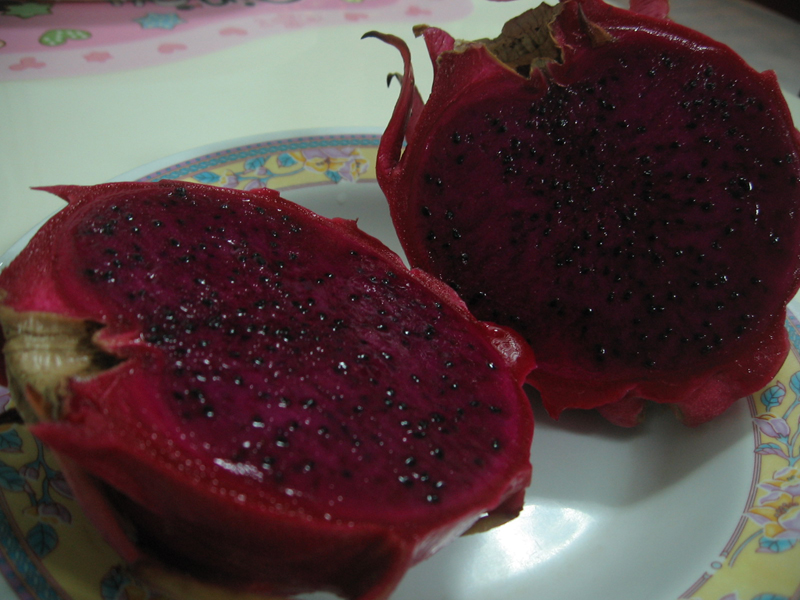
TWT154 Red Pitaya, Red Dragon Fruit ( Hylocereus costaricensis )
Also known as Costa Rican Dragon Fruit. A different dragonfruit with red, sweet and tasty fruits. It grows wild in central america in dry forests. This is the ancestor of many modern hybrids and to many conoisseurs it is still the tastiest, and the best tasting. Its fruits are all-red, especially rich in healthy indicaxanthin anti-oxidants.
Dragon Fruit is native to South America is popular with the Aztec Indians, being mentioned in historical documents dating to the 13th century, the fruit was also enjoyed by the Spanish Conquistador’s.
This Dragonfruit is a hemi-epiphytic fast growing climbing cactus that produces large and tasty fruits with neon pink skin and a striking red to magenta flesh that’s peppered with tiny black seeds. The seeds are quite small and can be eaten with the flesh – think kiwi.
The white to yellow flowers of this species are very large, reaching 8”-12” in length and contain many long narrow petals that make this a very striking flower. The fruit has a very refreshing flavor and is slightly sweet. Dragonfruit is a good source of calcium, fiber, and vitamin C that is low in calories. Perfect for juicing, smoothies, sorbet, or just to scoop out. Protect from Frost. Suitable for containers.
Zones 10 and higer outside, can be grown inside in cooler zones if good light provided.

3338 Yerba Mate ( Ilex paraguayensis )
Grow you own Yerba Mate and enjoy this popular South American tea as an alternative beverage to coffee. In Latin America, Yerba Mate is the beverage of choice and has a smoother taste than green tea, plus it’s loaded with antioxidants. The plant itself makes a wonderful potted plant for its graceful full-leafed branches. Under warm temperatures, it grows throughout the year, even in the north as a potted plant with flowers arriving during the winter/spring months. The leaves can be harvested once the plant is established. Grow in full sun with temperature above 65 degrees for fastest growth.
Hardy to Zone 10 and higher for outdoors.
Yerba mate was has been used as a beverage since the time of the ancient Indians of Brazil and Paraguay. In the early 16th century, Juan de Solis, a Spanish explorer of South America’s famed La Plata River, reported that the Guarani Indians of Paraguay brewed a leaf tea that “produced exhilaration and relief from fatigue.” The Spaniards tried the beverage and liked it. Their subsequent demand for the tea led the Jesuits to develop plantations of the wild species in Paraguay and yerba mate became known as “Jesuits’ tea” or “Paraguay tea.”
Methods of leaf preparation for the traditional tea beverage vary then and now: in one method, the branches are cut, then held over an open fire (to fire-cure the leaves). This deactivates the enzymes in the leaves (making them more brittle) and the green color of the leaves is retained in the subsequent drying process (with charred bits often found in the resulting tea product, which lends to a smoky flavor). Other methods include a brief par-blanching of the leaves in boiling water (to deactivate the leaf enzymes and soften its leathery texture). They then are toasted dry in large pans over a fire or inside a brick oven-resulting in a finished brown-leaf tea.
The wild plant has a distinct aroma and taste that has not been matched by plantation cultivation. In South America yerba mate is considered a national drink in several countries; in Europe, it is called “the green gold of the Indios.” In Brazil and Paraguay (leading exporters of mate), some production still comes from wild stands-most of which is found in the humid depressions of the foothills. It is not unusual for one wild tree to yield 30-40 kg of dried leaves annually. In wild harvesting, mate gatherers, called tarrafeiros or yebateros, travel through the jungle searching for a stand of trees (called a mancha). Harvesting is done between May and October, when the tree is in full leaf. Leaves are picked from the same tree only every third year, which protects it for subsequent crops. Most of the mate in commerce today, however, comes from large cultivation projects in Paraguay and Uruguay.
The word mate is Spanish for “gourd,” and refers to the small gourd cup in which the tea beverage traditionally is served throughout South America. It is also served with a metal drinking straw or tube, called a bombilla, which has a filter attached to the lower end to strain out leaf fragments. The bottom third of the gourd is filled with fire-burned or toasted leaves, and hot water is added. Burnt sugar, lemon juice, and/or milk often is used to flavor the refreshing tea, which occupies a position rivaling that of coffee in the United States. Mate bars are as prevalent in South America as coffee bars are in North America and Europe; mate drinking has deep cultural roots.
In addition to its standing as a popular beverage, yerba mate is used as a tonic, diuretic, and as a stimulant to reduce fatigue, suppress appetite, and aid gastric function in herbal medicine systems throughout South America. It also has been used as a depurative (to promote cleansing and excretion of waste). In Brazil, mate is said to stimulate the nervous and muscular systems and is used for digestive problems, renal colic, nerve pain, depression, fatigue, and obesity. A poultice of the leaves also is applied topically to anthrax skin ulcers (for which mate’s tannin content – highly astringent – may be the reasoning behind this use).

3630 Sweetheart ( Iochroma sp. )
This is an interesting plant for zones 9 and higher outside, but could be grown in tubs and brought inside in cooler zones.
A member of the Solanaceae ( nightshades ), Iochromas are more refined with smaller leaves and brightly colored tubular flowers that flare at the tips, and come in large, densely flowered clusters.
This is a small shrub with simple, grayish green leaves and attractive, reddish, tubular flowers in terminal clusters, followed by cherry-sized, golden yellow, heart-shaped fruits that are edible and sweet.
Zone 9b and higher outside.
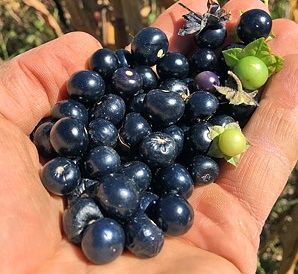
3636 Jaltomato Procumbens
A South American fruit, with a sweet, spicy taste similar to grapes or tomatoes. These easy-to-grow plants can grow as short-lived perennials but are better grown as annuals in cooler climates.
The fruit has a pleasant taste and aroma and is prized as a food source by many.
This little tomato is found across Mexico and it’s mostly used in the cuisines from the states of Oaxaca, Veracruz, Tamaulipas and Jalisco. It is rarely found in markets, and when it is, usually in small quantities. The ripe fruit has been used economically in parts of Mexico fresh, dried, in jams or preserves. Only completely ripe fruit are to be eaten, as green berries and the rest of the plant may be poisonous. The plant grows like a tomatillo plant and the berries are a decent size and produces well even in poor sandy soils.
This type of “berry tomato” is very juicy, has lots of seeds and a thick skin, peculiarities which the people who consume it enjoy. Said to taste like a sweet and spicy cross between a tomato and a grape, it can be eaten raw or made in to a delicious jam. Definitely is a plant for super food and gourmet for vegan fans.
Plants produced many cherry-sized black berries. They fall off when ripe. It is also a folk medical plant of Kamasa Indians in Columbia and Tarahumara Indians in Mexico. Plants can be grown like commonly tomatoes. This true perennial and can live many years in conservatory. In spring it shoots up from stout roots.
As with other members of the Solanum family, such as tomatoes and aubergines, jaltomata may require staking or some form of support.
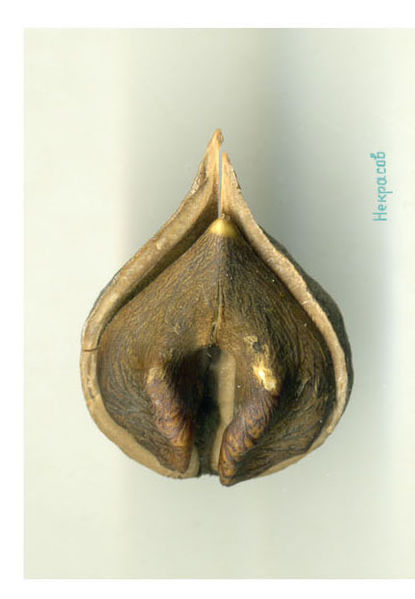
FDR07 Butternut ( Juglans cinerea )
Butternut, also called white walnut or oilnut, grows rapidly on well-drained soils of hillsides and
streambanks in mixed hardwood forests. This small to medium-sized tree is short lived, seldom reaching the age of 75.
Butternut is more valued for its nuts than for lumber. The soft coarse-grained wood works, stains, and finishes well. Small amounts are used for cabinetwork, furniture, and novelties. The sweet nuts are prized as a food by man and animals.
The kernels are sweet, oily and tasty, having a buttery flavor as per the common name. Native Americans used the nuts for food and boiled the tree sap for syrup. This species is sometimes commonly called white walnut because of the light color of the wood.
Butternut is easily grown but must be transplanted early because of the quickly
developing root system. Hardy for zones 3-7.
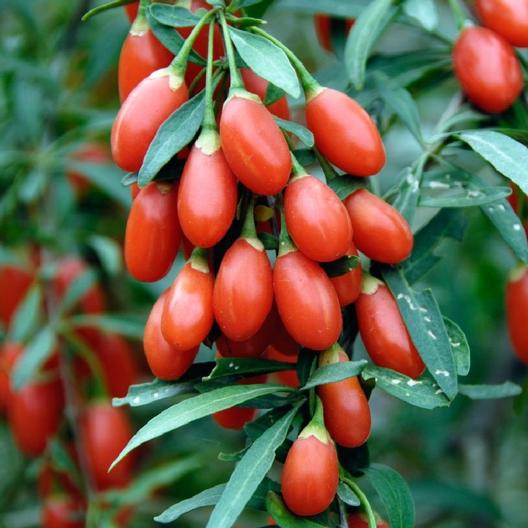
H119 Chinese Wolfberry, Goji Berry ( Lycium barbatum )
Known to some as Chinese Wolfberry, Goji is a woody, perennial shrub that produces bright red berries in the summer and fall. Much lauded as a “superfruit” in recent years, Goji has been used medicinally in China for centuries. Extra sweet and super nutritious, Goji berry plants produce a valuable harvest you can freeze, dry, juice and of course, eat raw like a blueberry or cranberry or dry and use like raisins.
With its purple flowers, attractive foliage and bright berries, Goji berry plants make a wonderful addition to your perennial garden.
Plant prefers full sun and fast-drying soils. High desert conditions are quite conducive. Goji plants are drought-tolerant.
A graceful shrub that bears large edible berries. The leaves are also edible when fresh and used in salads. A wine is made from the fruit that is said to prolong life. A perennial for zones 5-9.

3519 Black Gojiberry ( Lycium ruthenicum )
And what is highly unusual for fruits, they are rich in essential fatty acids. This combination of protective, healing and nutritive constituents help explain the many benefits of this plant. It is traditionally used to treat diabetes, anemia, heart disease, impotency, abnormal menstuation, menopause and problems of the liver and kidneys. It reduces cholesterol, helps regulate blood pressure, and improves circulation.
It also improves vision problems and dizziness. In Kashmir it is used to treat blindness in camels. Studies have shown that black gojiberry protects against radiation and may help reduce the side-effects of radiation therapy. As well, the berries boost the immune system and help prevent or slow the growth of cancer.
Black gojiberry is a spiny shrub found in dry areas from Turkey and Armenia to Tibet and northwestern China. It does well in dry, well-drained soils, and requires full sun. The seeds germinate readily but the seedlings are susceptible to damping off and control of damping off is necessary for best results.
Best sown in spring, kept in pots the first season, and then planted in the garden the following spring. Depending on conditions, plant will grow from 16-36 inches tall.
Based on its natural range we believe it is hardy to at least zones 4 to 7. It can be grown in warmer zones if provided with partial shade during the day.
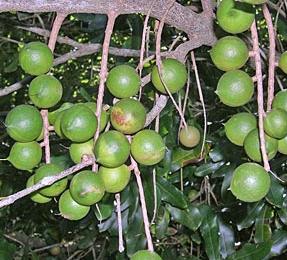
1A365 Macadamia Nut “Beaumont” ( Macadamia integrifolia x M. tetraphylla )
Beaumont is a superior hybrid variety of Macadamia nut for commercial orchards as well as home gardens. It grows quickly and bears a reasonable amount of good quality nuts after just 4 years and after 8 years can produce about 18 kg of nuts per tree. The nuts are easier to dehusk than most other varieties. It is well suited to most warm temperate and tropical climates in USDA Zones 10 and 11. Macadamia grows into a large tree unless pruned and makes a nice ornamental. Beaumont has attractive, maroon new growth. What most people do not know is that the pink flowers are wonderfully and intensely fragrant. Seeds should be soaked for a few days before sowing but shells must not be cracked. Germination is slow and erratic and usually takes place over several months.
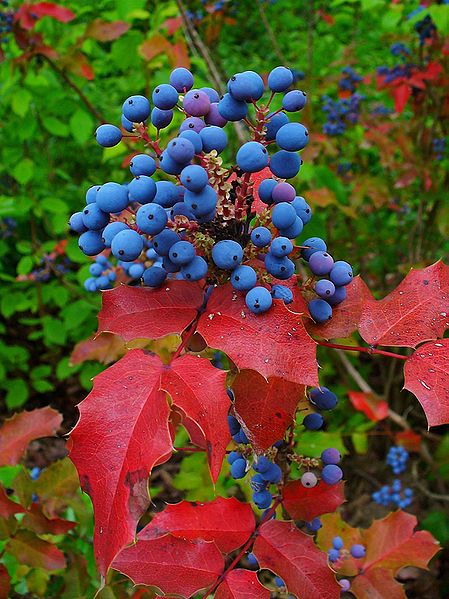
2121 Oregon Grape ( Mahonia aquifolium )
Location: Oregon grape holly is native from the northwestern United States on into Canada. It is widely grown as an ornamental.
Culture: Light: Needs shady conditions, hot direct sun will burn leaves. Moisture: Likes moist soil high in organic material, but adaptable. Hardiness: USDA Zones 5-9.
Propagation: Clumps can be divided.
Usage: This plant thrives in shady areas where selection of plants is limited. Can be used in entry ways and under roof eaves if adequate moisture is maintained. Looks great under a canopy of pine along with azaleas and camellias. Can also be used as an outdoor container plant.
Features: The bright yellow flowers are beautiful against the lustrous blue green leaves. The bright blue berries on dark red stems are even more striking. The grape like berries can be made into jelly.
Oregon Grape Jelly Recipe.
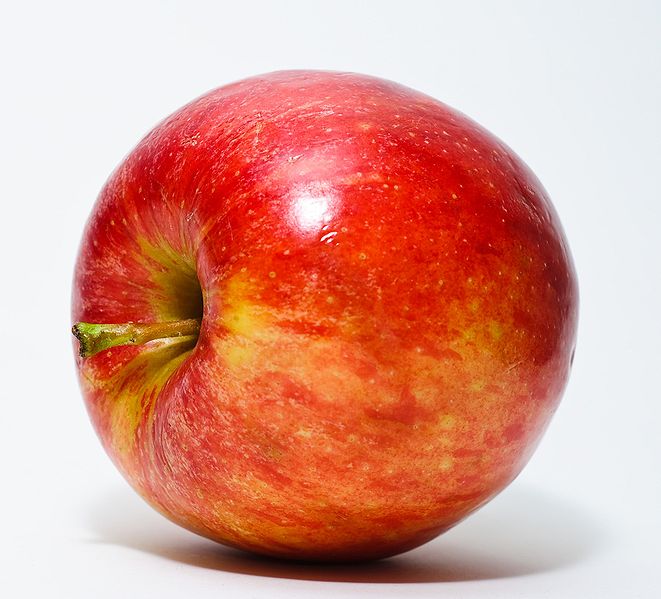
SF079 Paradise Apple ( Malus pumila )
An heirloom apple with many uses. Can be eaten raw, cooked in pies, cakes etc. or fermented into cider. The taste is sweet and pleasant when fully ripe. This is a common rootstock plant as well. Zones 4-9.
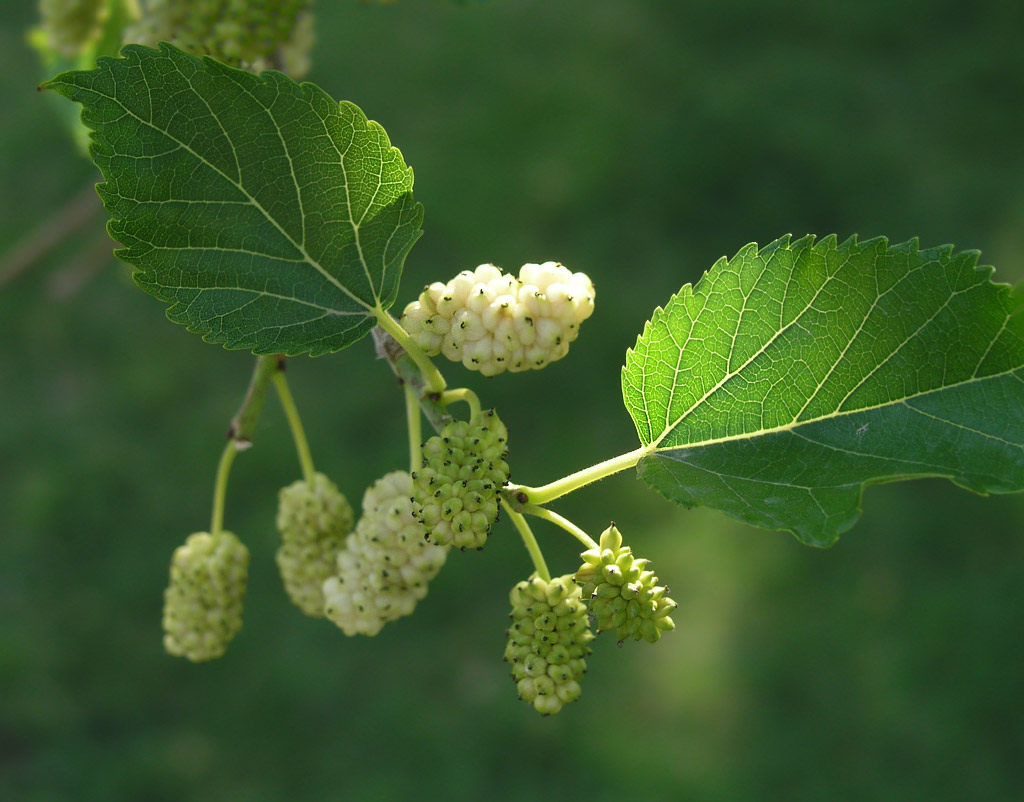
D2225 Russian Mulberry Tree ( Morus Alba )
Commonly called white mulberry, this is native to China. It is a rounded, fast-growing, deciduous tree that typically grows to 30-50′ tall and as wide. It usually develops a wide-spreading crown with age. The leaves of this tree have been used in China since at least 2600 B.C. as the primary diet for silkworms used to make silk. Trees were introduced into North America in colonial times in an effort to establish a silk industry. Although the industry never took hold, the trees did take hold and have over time escaped cultivation and naturalized in fields, waste areas, forest margins and along roads throughout much of the U.S.
This tree has also been planted in various areas for erosion control and windbreaks. White mulberry is usually dioecious (separate male and female trees), but sometimes is monoecious. Small yellowish-green flowers in drooping catkins bloom in spring (March-April). Fertilized flowers on female trees are followed by sweet, edible blackberry-like fruits (cylindrical drupes to 1″ long) that mature in June. Fruits ripen to white or pink, but sometimes to darker reds or purple-blacks. Fruits are loved by birds.
Best suited for zones 4-9.
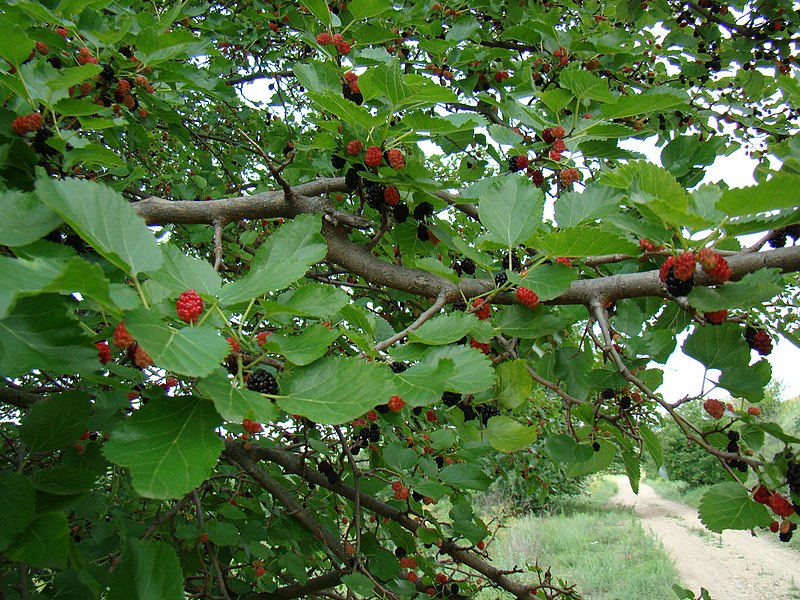
Yuriy75, CC BY-SA 3.0, via Wikimedia Commons
D2226 Black Mulberry ( Morus nigra )
A heavy fruiter like the Russian Mulberry but is preferred because it grows only a third as tall and is easier to harvest. Great pies and wine can be made from the fruit.
I’ts said that if you like blackberries, then you will love mulberries. No thorns and it is easy to grow your own tree! Each tree produces succulent mulberries that are both delicious and nutritious and offer even more juicy flavor than blackberries.
The fruit grows in abundance from June to August. The berries ripen over an extended period of time, providing a delicous snack all summer.
These tress grow quickly, and in few short years uou can pick baskets full of large, black mulberries so sweet there’s no need for sugar, and mulberry lovers know this fruit is to be prized because its intense flavor is like no other. A lovely specimen tree whose fruit will keep you in jam and wine all winter long. Berries also freeze very well. One of the few trees that actually prefers heavy soil to achieve its lifespan of a hundred years or more.
Grows about 15 feet tall and spreads about 12 feet, does well in zones 4-10.
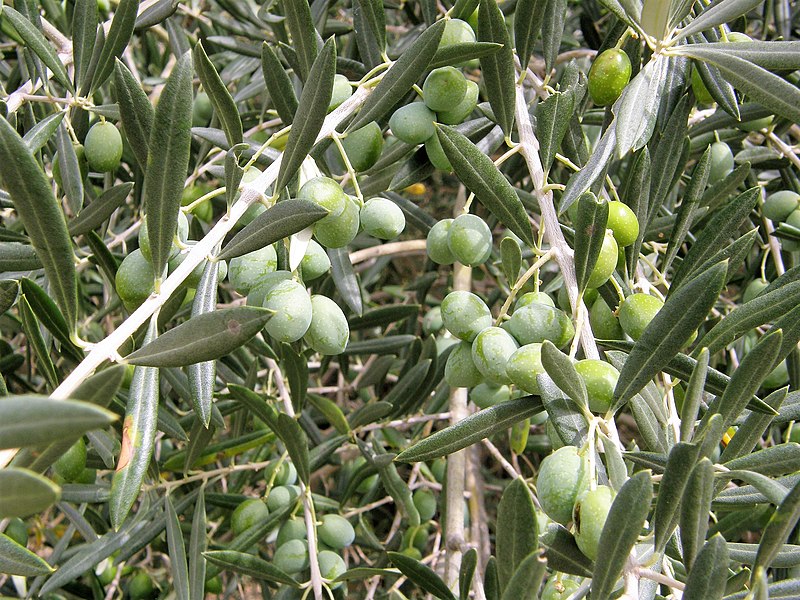
D2228 Common Olive ( Olea europaea )
A most useful tree that can be grown in any temperate climate ( zones 8-11 ).
It also can be grown in containers. The tree itself is
attractive and usually becomes gnarled with age. It bears the
olive of commerce that reach up to 1-1/2″ in dia. and are
filled with oil. The flowers are tiny and yellow, the foliage a
light grey-green.
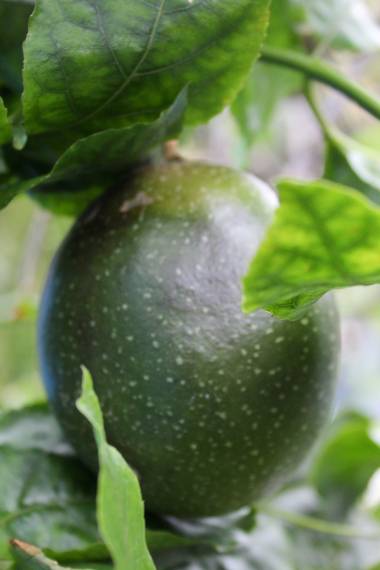
SF408 Tango ( Passiflora edulis )
Tango is a selection from a hybrid between two well known Passiflora edulis cultivars, ‘Pandora’ and ‘Panama Red’. It produces excellent, large, reddish fruits that are full of sweet pulp and juice. It is also quite tolerant of cool conditions and can take brief freezes.
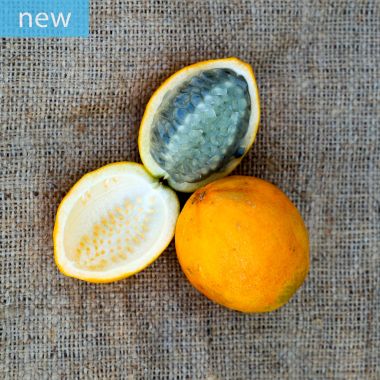
JF747 Perfect Passionfruit ( Passiflora popenovii )
The rare P. popenovii produces arguably the most delicious fruit of all Passiflora. The translucent and very juicy flesh inside the bright yellow fruit is extremely sweet and has an exquisite, exotic and perfumed flavor. It was native to rainforests in Colombia and Ecuador between 1600 and 6200 feet, but is believed to have gone extinct in the wild and only persists in cultivation locally.
It will easily adapt to being grown in a wide range of tropical and warm temperate climates. We think the Perfect Passionfruit has the potential to become far more popular than Passiflora edulis, which is a common sight in fruit markets worldwide.
The plants do extremely well in containers and are hardy in the landscape in USDA zone 9-11.
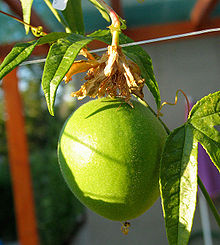
D9930 Maypop ( Passiflora incarnata )
A North American species that grows to only six feet or so, making it an easier variety to keep under control. This is a very herbaceous vine and dies back every Winter, only to pop back in May, hence the name Maypop ( though I think the names comes from stepping on the fruit and the pop it makes ).
It climbs by means of clinging tendrils and can be kept as an container plant. The long tendrils need lots of support for climbing. It may be grown as a houseplant in a sunny South-facing window. It has large scented flowers, from June to November, with pale lavender petals and purple filaments which are kinked at the tip. These are followed by sweet edible fruits which are yellow when ripe. The leaves are tri-lobed and 15 cm large. Pruning is a must to keep the vine healthy. Prune off less vigorous growth and occasionally prune back vigorous growth to promote flowering.
When established, and without care, the passion fruit can easily overtake other garden plants, shading them from sun. One of the easiest Passiflora to grow and has the best cold hardiness. Keep the atmosphere humid through the Summer and place in full sun, can tolerate partial shade. You may need to water your plants on a daily basis during the hottest Summer months. During the Winter the roots should be kept moist, but as growth will be much slower you will probably only need to water once a week, depending on growing temperature. It will do best in a loam based mix with a little peat moss.
Fertilize at least once every two weeks in the growing season.
If their pot is too large or if they have an unrestricted root run then the whole plant will simply get bigger and bigger but it will refuse to flower and therefore produce the fruits. By limiting the pot size you are limiting the ability to grow and this is seen as a threat, so the natural mechanism is to produce seed for the next generation. A suitably sized pot for an adult plant would generally be of 12 inches in diameter.
Hardiness zone 8-11.
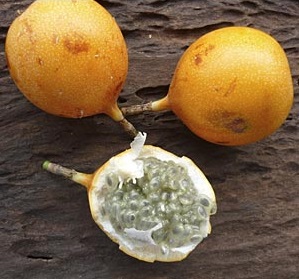
IP189 Sweet Granadilla ( Passiflora ligularis )
A vigorous vine that is woody at the base and climbs onto structures or high into trees using tendrils with heart-shaped 4 to 8 inch long leaves that are of a medium green color and paler below with prominent veins. In the warmer months of the year appear the 4 inch wide sweetly fragrant flowers, often in pairs at the leaf base. These flowers have greenish white sepals and light pinkish-white petals with 2 ranks of filaments that are banded with bluish purple.
The outer shell is hard and slippery, and has soft padding on the interior to protect the seeds. The seeds, which are hard and black, are surrounded by a gelatinous sphere of transparent pulp. The pulp is the edible part of the fruit and has a soft sweet taste. It is very aromatic and contains vitamins A, C, and K, phosphorus, iron, and calcium.
Winter Hardiness: 25-30° F
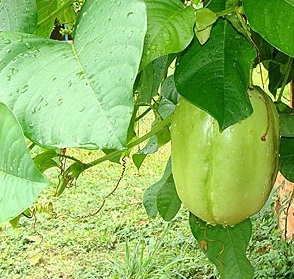
2640 Giant Granadilla ( Passiflora
quadrangularis )
The Giant Granadilla forms a larger leaf and is a more vigorous
grower than the yellow passion fruit. This plant derives its
botanical name from the fact that the stems are quad rangular
in cross section. It is a vigorous grower that can grow 50 feet
or more in a single season, for zones 10 and higher, or warm
greenhouses.
Fruit of the giant granadilla reach a length of up to 12 inches
and turn yellow when mature. The pulp around the seeds is used
to flavor ice cream and to make a cooling drink. In addition,
the flesh of this fruit is edible. The green fruit is boiled
and eaten as a vegetable. The fully ripe flesh is eaten alone
or in combination with such fruits as papaya and pineapple
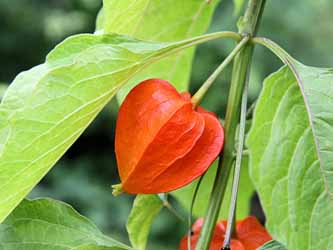
3552 Chinese Lantern ( Physalis alkekengi )
An easy to grow perennial that is normally grown as an annual as it re-seeds easily. Edible berries are borne inside fascinating orange chinese lantern-like calyces. Berries are eaten raw, or in preserves and pies. Recommended for fevers and gout.
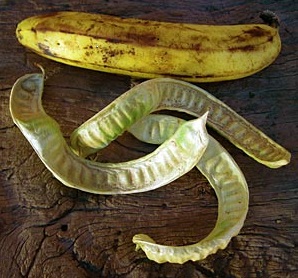
SF368 Chilean Carob Tree ( Prosopis chilensis )
A small tree with feathery foliage in the Fabaceae (pea family), native to the arid regions of northern Chile, southern Peru and northern Argentina. The fruits are similar to carob and are used to make a rich sugary flour.
The dried fruits are placed in a blender and the resulting flour is sifted and added to desserts, pastries, soups and even ice-cream. The dried pods are also nibbled on as a delightful snack. These trees are beneficial as Nitrogen fixers. They grow quickly and are extremely hardy. The variety offered here is one of the larger fruited forms from the Atacama desert in Chile.
In cultivation, Prosopis chilensis can take moderate freezes and severe droughts and can be grown in dry climates of USDA zones 8 to 10.
Seeds are easy to sprout but need to be scarified and soaked before sowing.
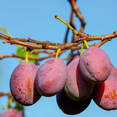
TRZ122 American Plum ( Prunus americana )
In our opinion, nothing is better than eating a fresh plum directly off the tree! The American Plum is a fast growing selection with many uses. This plum will grow as a small tree or large shrub which will readily sucker from the ground up around the root zone. When suckers are not trimmed regularly, it will transform into a large erect shrub and form a dense spreading thicket as it ages. In the spring, clusters of 1″ white flowers will form, usually some of the first flower blooms in the woodlands. Fruit will form over summer, and mature in August and September. The plums can be used in jellies, preserves, and even eaten raw.
Prunus americana thrives in USDA hardiness planting zones 3 to 8 and prefers thicket, open field, or woody habitats which get at least 16″ of rain per year and is often seen along roadsides and in pastures. It does best in well-draining soil and is a good choice for windbreaks and general landscaping beautification. Due to its bushy, slightly tangled foliage structure, this tree is a great choice to add visual interest to any yard.

3395 Chickasaw Plum ( Prunus angustifolia )
Like other plums, this one is armed with lateral twigs that end in sharp spines.
Chickasaw plum characteristically forms dense thickets. The flowers of Chickasaw plum come out before the leaves in late winter or very early spring on the previous year’s wood. They are white with a mild fragrance and less than a half inch across, but they cover the entire bush with a spectacular show when almost nothing else is blooming. Chickasaw plum fruits are oval in shape, usually red, and quite tart to the taste.
Chickasaw plum is easy to grow in almost any soil except strongly alkaline. Mow or prune unwanted suckers and seedlings that appear around the base of the plant, or let it form an attractive thicket that will be welcomed by butterflies, song birds and other wildlife.
Like other plums and cherries, Chickasaw plum does best in full sun, but hangs in there in partial shade. Established Chickasaw plums are drought tolerant. USDA Zones 5-9.
In early spring, before most shrubs and trees have even started to leaf out, the Chickasaw plums are in full bloom – billowing white clouds along southern highways. This is a handsome little shrub, perfect for the semi shaded woodland area in the back of the yard. They grow naturally in dry, sandy soils and, once established, need no supplemental watering. The fruits, although tart, are used to make jelly by folks in the know, and eaten fresh by animals in the know. The flowers will attract native insects and the plums will attract native wildlife. The original Americans ate the plums and dried them for keeping. Chickasaw plum, with its attractive bark, small leaves and slender branches, has been used for bonsai.
Chickasaw plum should be a part of any native (to the U.S.) landscape planting. They are maintenance free, produce a beautiful flower show, and attract wildlife.
For zones 2-7.
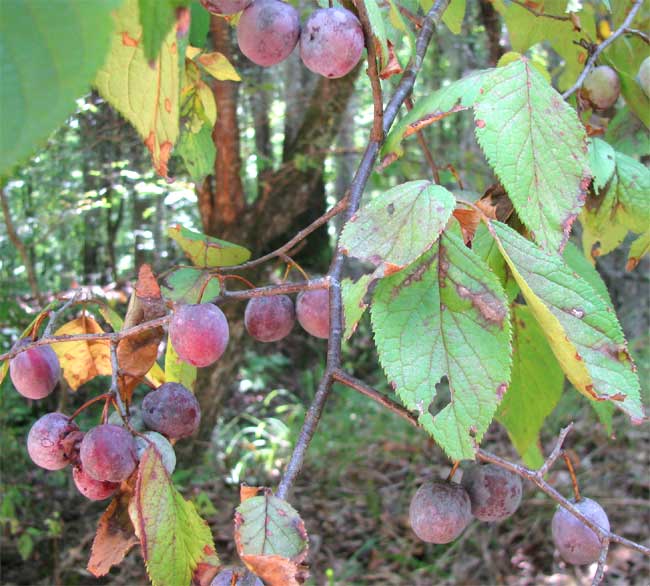
TRZ054 Mexican Plum ( Prunus mexicana )
Prunus mexicana, commonly known as Mexican plum and also Bigtree plum, is a small, upright tree that may grow to a shrubby 8-15’ tall but most frequently matures to 15-25’ tall. It is native from the southeastern corner of South Dakota to Ohio south to Alabama, Texas and northeastern Mexico. Trees are also widely cultivated on the West Coast.
Main features of this tree are the fragrant showy white flowers in small clusters which bloom in spring before or as the leaves appear, the leaves that are 5” long and 2” wide which are yellow-green above and soft hairy beneath with double-toothed margins, and the edible plums that reach to 1” diameter which emerge yellow but ripen on the tree from July to September to rose, lavender or purple covered with a gray-glaucous bloom
It also has smooth reddish-gray bark which matures over time to blue-gray with a rough texture, darker horizontal striations and exfoliating patches, and yellow, but sometimes a more attractive orange and red, fall foliage color.
Plums may be eaten fresh off the tree or made into tasty preserves and jellies.
For zones 6-8.

3394 Sloe ( Prunus spinosa )
Prunus spinosa is a large deciduous shrub or small tree growing to 15 feet tall, with blackish bark and dense, stiff, spiny branches. It is hardy to zone 4. The leaves are oval, 2-4.5 cm long and 1.2-2 cm broad, with a serrated margin.
In late February and early March, the blackish branches are hidden underneath dense clouds of fluffy white flowers. The mid-sized, dark green, oval leaves emerge after the flowers and the fruit, called sloes or sloe berries, ripen in late autumn, with a bloom of pale blue powder over the dark purple skin.
The fruit, called a “sloe”, is a drupe about half an inch in diameter, black with a purple-blue waxy bloom, ripening in autumn, and harvested traditionally, at least in the UK, in October or November after the first frosts. Sloes are thin-fleshed, with a very strongly astringent flavour when fresh.
Blackthorn is much prized for walking sticks and only blackthorn or oak wood is used to make a real Irish sail eille (shillelagh in English). In Southern Ireland, County Kerry, there is a town called Killarney, which means “church of sloes”.
It makes good firewood.
Prunus spinosa is self-fertile and Sloe berries are traditionally used for infusing with gin, vodka and brandy, but they also make good jam. In colder parts of the country where frosts come early, you can try leaving ripe Sloes on the branch; a touch of frost will make them surprisingly sweet.
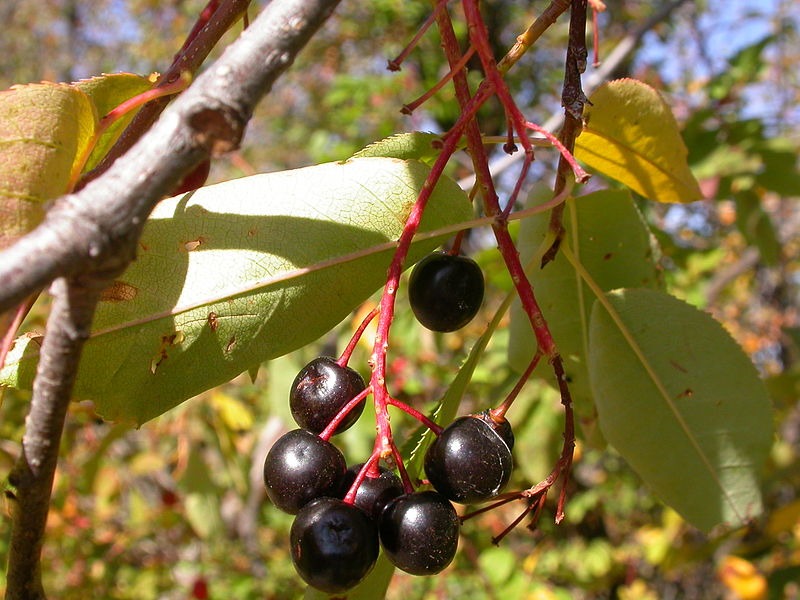
PR02 Wild Black Cherry ( Prunus Virginiana )
For zones 2-6. A medium size cherry tree; height usually not
over 20 to 25 feet, diameter 4 to 8 inches; with an irregular,
rounded crown. Bright green, broadly oval leaves, paler
underneath; length 3 to 4 inches, width 1 to 2 inches. Fruit is
in dense clusters; reddish, turning nearly black when fully
ripe; each berry containing a single seed, skin of fruit thick;
flesh thin and dark; very astringent to the taste, but edible.
Popular tree for birds. Most widely distributed tree in North
America, extending from the Arctic Circle to Mexico and from
the Atlantic to the Rockies.

TRZ053 Schubert Chokeberry ( Prunus virginiana Shubert )
‘Schubert’, sometimes called purpleleaf chokecherry, is a deciduous, suckering tree or shrub with a pyramidal habit which grows 20-30′ tall. It is best known for its purple foliage: elliptic to obovate leaves to 5″ long emerge green in spring, gradually maturing to dark purple by early summer.
White flowers in racemes in spring give way in summer to clusters of reddish cherries about one third inch in diameter which mature in fall to a dark purple.
Fruit is very astringent, hence the common name. Fruit may be used in sauces, jellies and preserves, however. Fruits are attractive to wildlife.
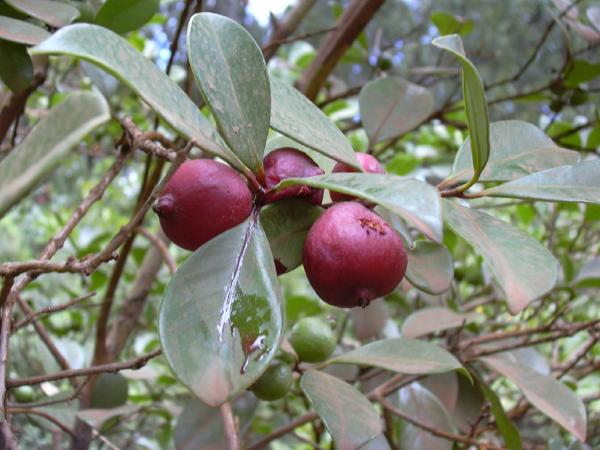
D2261 Strawberry Guava ( Psidium cattleianum )
Can be grown indoors in containers or as a tree outdoors to 15 feet, in containers it will be limited to the size of the container. The fruits are very versatile. They can be eaten out of hand. Makes great juice, jelly, mousse, Guava butter and Guava pudding. Cold hardy to 25 degrees.
This guava does well in limestone and poor soils that would barely support other fruit trees. It is shallow-rooted but is fairly drought tolerant.
A delicious puree or tart-filling can be made by trimming and cooking 6 cups of red cattleys with 1 cup water and 2 cups granulated sugar and pressing through a sieve.

3341 Apple Guava ( Psidium guajava )
A shrub or small tree, sometimes growing as high as 30ft, but usually no more than 10-15ft.
Highly fragrant fruit usually with green or yellow skin, about the size of a baseball, with pink or white flesh. The guava is one of the most common fruits in the world and its sweet pulp is used in a wide assortment of drinks, desserts, and other food products.
Hardiness: The guava is highly adaptable to tropical and subtropical environments and can be grown outdoors as far North as the San Francisco Bay Area in California, as well as most areas of Florida and gulf coast states. Protect from temperatures below 30F, which can cause defoliation. Harder freezes will kill the plant. In cool winter areas, guava’s may partially defoliate, but should begin new growth flushes in spring and summer.
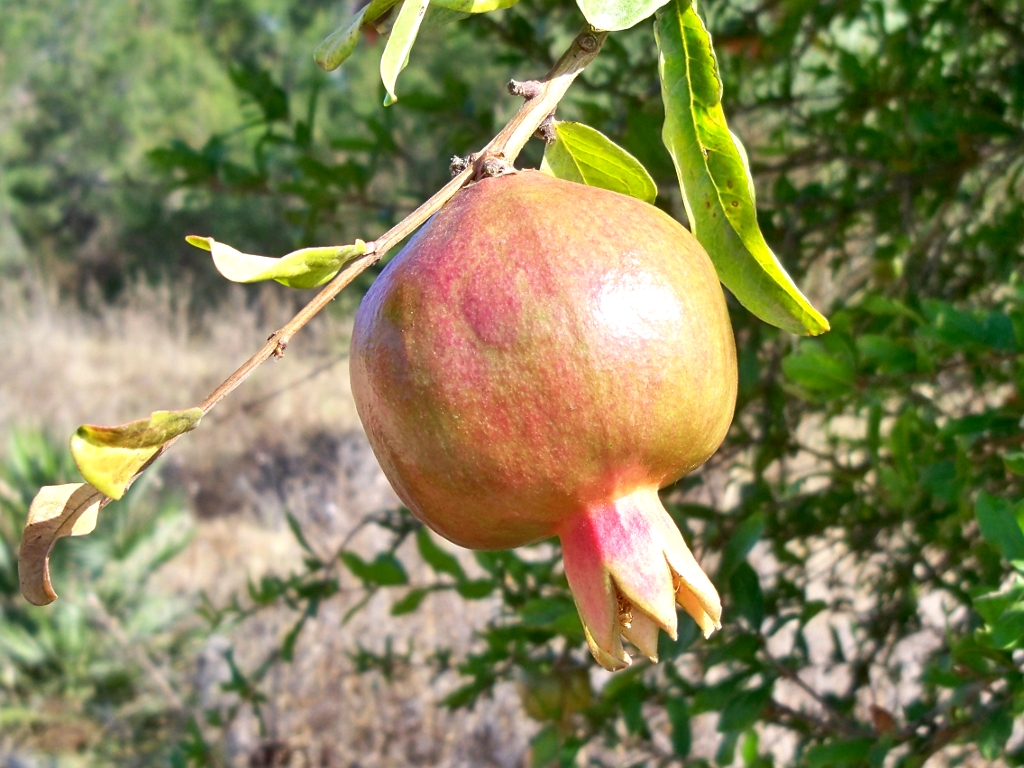
D2267 Pomegranate ( Punica )
A very decorative ornamental that has a pleasant tasting fruit. It has vermilion red flowers and small glossy leaves.
Pomegranates are adaptable to many soil types, though they grow best in loamy soil with good drainage. The ideal climate is zones 7 to 12, with short, mild winters and low humidity. They may be grown in containers in colder places, and kept indoors or in a greenhouse over winter.
It is not necessary to prune your pomegranate trees, but it can help with ease of harvest, better fruit, and for a shapelier tree. Pomegranates naturally grow in bush-form, and produce lots of suckers. This is ideal for hedges or living walls, but not for most other situations.

3182 Firethorn ( Pyracantha coccinea )
Birds love the fruit. They are greatly favored by Black Birds and Cedar Waxwings, which have been know to strip a tree of all its berries.
Here is a link to a great web page about Firethorn and includes a recipe for Pyracantha Jelly.
Firethorn is a large, evergreen shrub that is cherished for its spectacular fall and winter display of scarlet fruits and ability to withstand dry and droughty conditions. Shooting long lanky stems in all directions, firethorn typically grows into a tangled mound up to 10 feet in height and 12 feet wide. It is armed with sharp thorns that hide among the dark,glossy green leaves.
Clusters (corymbs) of small white flowers appear in spring. These are up to 2 inches across and are borne close together creating the appearance of nearly solid surface of flowers. In fall the 1/4 inch berries begin to ripen, their color mellowing from green to shades of red, orange, or yellow. These persist through winter and into early spring depending on climate and appetite of the local bird population. Under bright sunny conditions the berries are plentiful but expect smaller crops in shadier situations. The color of both leaves and berries tends to be darker in cooler climates.
Culture: Not particular about soil and requires little or no supplemental fertilization.
Light: Full sun preferred but will grow in partial to fairly heavy shade. Flowering and fruiting will not be as heavy.
Moisture: Moist to very dry, well drained soil. Hardiness: Zones 5 – 9.
Usage: Pyracantha is often used as an espalier. Held flat against a wall, it can be shaped quite creatively. Because of its fast growth rate, sprawling, spreading habit, and ease of care, it can be used on slopes to great advantage requiring little maintenance or care. The wide-reaching stems may be pruned back as needed during warm weather as the shrub blooms on old wood. Even consider using it as an informal hedge! This will require some trimming and shaping for the first few years but the effort will produce impressively beautiful and secure
(thorny) hedges.
Landscapers love the firethorns for their fast rate of growth and ability to withstand drought and neglect. The shrubs ruggedness and disease and pest resistance makes this plant a very popular item in commercial landscapes.
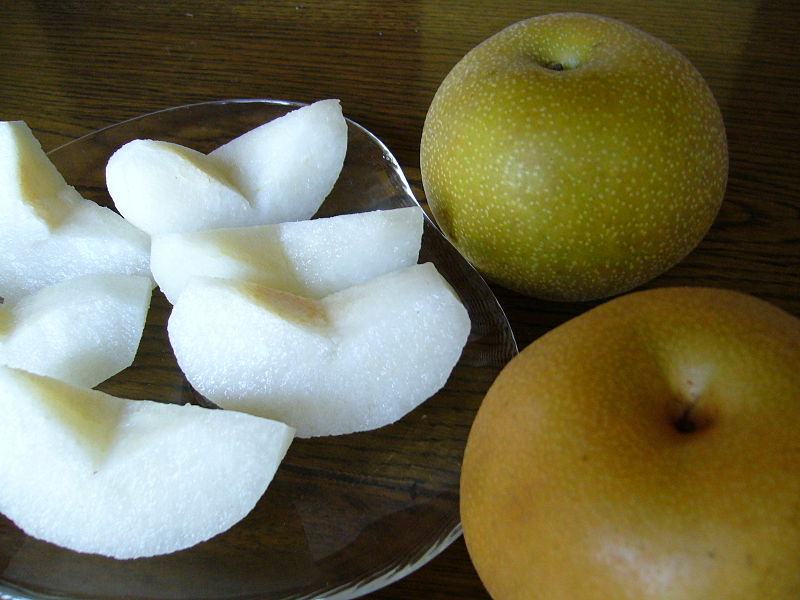
3396 Asian Pear ( Pyrus pyrifolia )
It is hardy to zone 6 and is not frost tender. It is in flower in April, and the fruit ripens in September. The flowers are hermaphrodite (have both male and female organs) and are pollinated by Insects.
Suitable for: light (sandy), medium (loamy) and heavy (clay) soils, prefers well-drained soil and can grow in heavy clay soil. Suitable pH: acid, neutral and basic (alkaline) soils. It can grow in semi-shade (light woodland) or no shade. It prefers moist soil and can tolerate drought. It can tolerate atmospheric pollution.
Asian pears are cousins to the pears that are typically seen in grocery stores, but this fruit is similar to an apple and its many names reflect that characteristic. Other names that this fruit goes by are: Chinese pear, Japanese pear, Sand, Nashi, and apple pear.
Asian pears differ from the traditional European ones. These pears are usually round, firm to touch when ripe, and are ready to eat after harvest. Asian pears reach prime quality when they ripen on the tree, like an apple and peach. These pears will be crisp, juicy, and slightly sweet with some tartness, especially near the core.
Note: These seeds will require cold stratification, you may need to purchase our Cold Stratification Kit

JB070 Alleghany Blackberry ( Rubus allegheniensis )
These plants are hardy to zone 3 and provide loads of delicious sweet fruit in the summer. Does have thorns, but this variety will outproduce ( fruit ) the thornless varieties we have tested.
Alleghany Blackberry is a deciduous Shrub growing to 3 m (9ft 10in) at a medium rate.
It is hardy to zone 3 and is not frost tender. It is in flower from May to July, and the seeds ripen from Aug to September. The flowers are hermaphrodite (have both male and female organs) and are pollinated by Apomictic.The plant is self-fertile.
Hardiness zones: 3-9
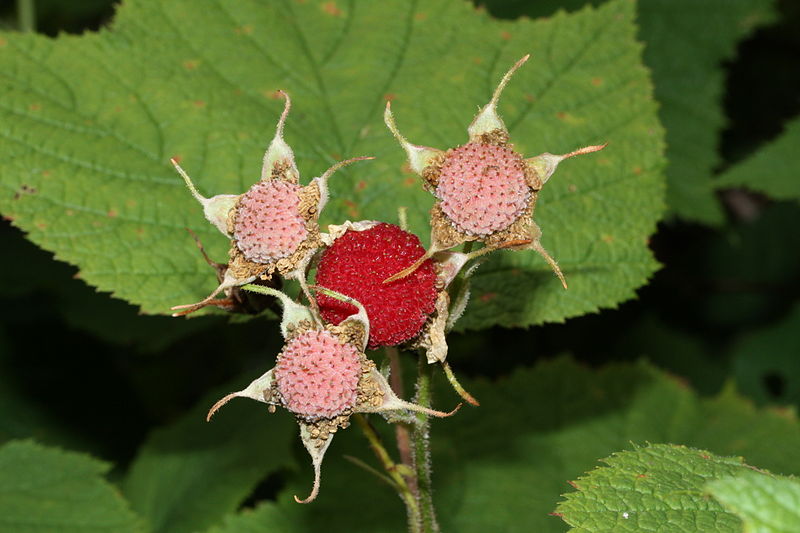
3358 Thimbleberry ( Rubus parviflorus )
A decidious shrub growing to 4 feet. Has large maple-shaped leaves. White flowers in spring produce edible red fruit. It does not like wet, soggy soil and prefers some light shade.
Thimbleberries are good subshrubs for use as streamside erosion control. It forms thornless bramble thickets with good soil-binding attributes. Because it is vigorous and adapts well to sun or shade, it makes a fine native species for re-vegetating disturbed moist areas, especially those spots located in shade.
The raspberry-like fruit make tasty jams, jellies and syrups.

SF170 Salmonberry ( Rubus spectabilis )
Attractive pink/ magenta flowers, attracts hummers, golden stems lightly covered with prickles, edible raspberry-like fruit. Thicket forming.
The upright, arching branches vary from nearly thornless to quite thorny, and are apt to grow to ten feet, if left unpruned. It blooms in early spring shortly before the full development of the large, palmate leaves. The flowers are an eye-shocking pinkish-purple that are a magnet for hummingbirds, and are a striking contrast to the bright green of the new leaves that follow. The fruit, which also resembles the raspberry, is small, orange to red. The flavor can vary widely, but it is generally considered tastier than thimbleberry. But even if you don’t like the taste, birds finding their way to your garden definitely will. Found along streams and in moist woods, this is the one for wetter areas. It too will create a formidable thicket that birds find good protective cover.
Fruit can be used raw, cooked or dried for later use. Juicy with a very good flavor. The fruit can be made into jams and jellies. The fruit can range in color from yellow, through orange to red, it is about the size of a cultivated raspberry but is rather inferior in flavor and often has a distinctive bitterness, especially in cooler summers. Young shoots can be peeled and eaten raw or cooked like asparagus. They are harvested in the spring as they grow above the soil and while they are still tender. Flowers can be eaten raw. The leaves are used as a tea substitute.
Easily grown in a good well-drained loamy soil in sun or semi-shade. Grows well in the shade of trees though it is less likely to fruit well in such a position. A very ornamental plant, but it can be invasive. This species is a raspberry with biennial stems, it produces a number of new stems each year from the perennial rootstock, these stems fruit in their second year and then die.
Can be grown in containers, hardy to zone 5.

H078 Black Elder ( Sambucus nigra )
This herb has long been used to heal hemorrhoid problems.
It gives immediate relief. To make a compress, mix the flowers of elder and honeysuckle
together and pour boiling milk over them. Let the mixture steep for about 20 minutes.
Dip a towel into the mixture and apply to the area of pain. An ointment can be made
from the green leaves that is also beneficial to hemorrhoids. Apply the ointment while it
is still hot. A perennial for zones 6-8.

3522 Magnolia Vine ( Schisandra chinensis )
Schisandra chinensis, commonly known as the Magnolia vine, is one of the most ornamental edible vines you could ever wish to grow. Scratch the bark and an intense, clean fragrance that’s a combination of Daphne odora and lime peel will greet your nose. The flowers of the Magnolia vine are insignificant, but the 4″ clusters of shiny red berries are gorgeous. They ripen in late summer on year-old wood. If the Magnolia vine is very happy, it will send up suckers from the rootball and you can propagate new vines from them.
Known as Wu We Zi in Mandarin (five taste fruit), Schisandra chinensis berries are one of the 50 essential ingredients in traditional Chinese medicine. Fresh Schisandra berries are much better tasting than the dried fruit, although both fresh and dried fruit are packed with nutrition.
This is a deciduous woody vine native to forests of Northern China and the Russian Far East. It is hardy in USDA Zone 4.
The plant likes some shade with moist, well-drained soil. The species itself is dioecious, thus flowers on a female plant will only produce fruit when fertilized with pollen from a male plant. There is no way to know if a plant is female or male until it blooms. ( Each seed pack contains 10 seeds, so you are assued of getting both male and female plants from each packet ).
Fruit is eaten raw or cooked. Usually dried and used on journeys, it is very sustaining and rich in sugars, it has a sweet/sour flavor.
The fruit is about 6mm in diameter and is borne in a grape-like bunch about 10cm long.
Extracts from the fruits (seeds) of Schisandra chinensis are one of the components of medicinal preparations designed for the treatment of cardiovascular diseases, liver diseases, diseases of the central nervous system related to the old age, as a supplement in the treatment of neoplasms, diabetes, etc. Schisandra extracts are also used for the production of nutraceuticals (soft drinks and health foods), preparations for oral hygiene and for the care for the skin and hair.
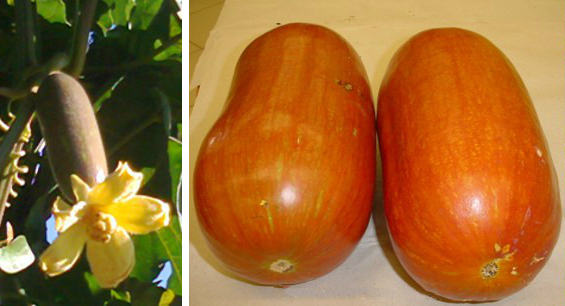
D8566 Cassabanana ( Sicana odorifera )
Young stems are hairy. The leaves are gray-hairy, rounded-cordate or rounded kidney-shaped, to 1 foot wide, deeply indented at the base, 3-lobed, with wavy or toothed margins.
Flowers are white or yellow, urn-shaped, 5-lobed, solitary, the male 3/4 inch long, the female about 2 inches long.
Renowned for its strong, sweet, agreeable, melon-like odor, the striking fruit is ellipsoid or nearly cylindrical, sometimes slightly curved; 12 to 24 inches in length, 3 to 4 inches in diameter, hard-shelled, orange-red, maroon, dark-purple with tinges of violet, or entirely jet-black; smooth and glossy when ripe, with firm, orange-yellow or yellow, cantaloupe-like, tough, juicy flesh.
The cassabanana is believed native to Brazil but it has been spread throughout tropical America.
Venezuelans and Brazilians are partial to the vine as an ornamental, but in Cuba, Puerto Rico and Mexico it is grown for the usefulness of the fruit.
A high temperature during the fruiting season is needed to assure perfect ripening. Brazilians train the vine to grow over arbors or they may plant it close to a tree. However, if it is allowed to climb too high up the tree there is the risk that it may smother and kill it.
The cassabanana remains in good condition for several months if kept dry and out of the sun.
The fruit has high market value in Puerto Rico. It is cut up and sold by the piece, the price being determined by weight.
The ripe flesh, sliced thin, is eaten raw, especially in the summer when it is appreciated as cooling and refreshing. However, it is mainly used in the kitchen for making jam or other preserves. The immature fruit is cooked as a vegetable or in soup and stews.
People like to keep the fruit around the house, and especially in linen- and clothes-closets, because of its long-lasting fragrance, and they believe that it repels moths. It is also placed on church altars during Holy Week.
Medicinal Uses: In Puerto Rico, the flesh is cut up and steeped in water, with added sugar, overnight at room temperature so that it will ferment slightly. The resultant liquor is sipped frequently and strips of the flesh are eaten, too, to relieve sore throat. It is believed beneficial also to, at the same time, wear a necklace of the seeds around the neck.
The seed infusion is taken in Brazil as a febrifuge, vermifuge, purgative and emmenagogue. The leaves are employed in treating uterine hemorrhages and venereal diseases. In Yucatan, a decoction of leaves and flowers (2 g in 180cc water) is prescribed as a laxative, emmenagogue and vermifuge, with a warning not to make a stronger preparation inasmuch as the seeds and flowers yield a certain amount of hydrocyanic acid.
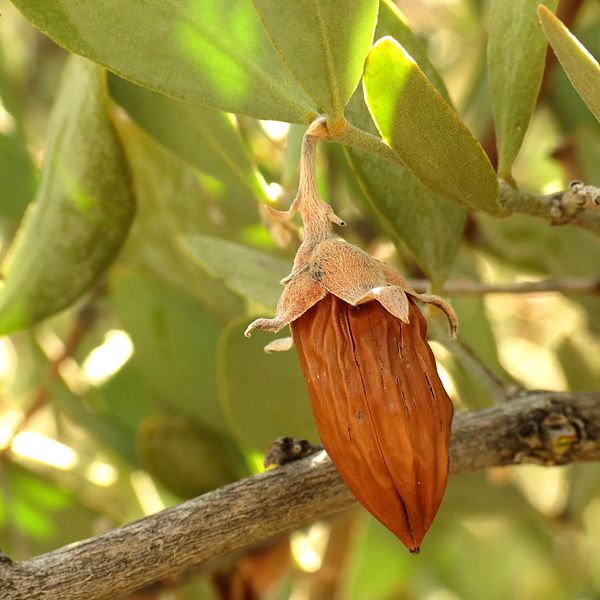
TRZ108 Jojoba ( Simmondsia chinensis )
Pick up a bottle of lotion at the store and you may recognize the name of this oily plant. Known for its moisturizing properties, Jojoba is widely found in cosmetic products. If you find this large bush in your area, you can also eat the nuts that are found on the female variety of the plant, containing seed pods. The nut has a bitter flavor similar to an almond.
This woody, evergreen shrub grows up to 8 feet tall and about 10 feet wide with leathery, grayish-green leaves. Jojoba occurs throughout the Sonoran Desert where annual average rainfall exceeds 5 inches. It extends beyond the desert into the coastal mountain ranges of southern California. Use jojoba plants as a screen, barrier, hedge, or desert revegetation.
Zones 9-11 or can be container grown in cooler zones.

IP151 Dwarf Tamarillo ( Solanum abutiloides )
A small, fuzzy, orange fruit related to the Tree Tomato. It has large, furry leaves, white flowers and the small, slightly furry, orange fruits are sweet when fully ripe with an aroma that reminds of peaches or abricots. It makes a fair ornamental for warm temperate regions but is more often grown for its fruits.
Great for containers. Grow in full to filtered sun. Water regularly during growth season. Use well-drained soil.

D9927 Naranjilla Juice Plant ( Solanum quitoense )
The Naranjilla is a tomato relative native to the northern part of South America and it’s cultivated usually at high elevations, between three and seven thousand feet. The plant can grow to heights of six to ten feet with very large spiny leaves, often measuring 18 inches long, and five to eight inches wide or bigger. The dark green leaves have purple veins on the upper surface and whitish or purplish on the lower surface.
It can be grown in tubs on patios and in greenhouses, where the size of the plant is controled by the size of the container it is grown in.
All parts of the plant are very pubescent and contain many thorns. The globular shaped fruit usually measure an inch and a half to two and a half inches diameter at maturity. They are bright orange and covered with short brittle hairs, which can be easily removed by rubbing. When cut open, the fruit
resembles a tomato with green, acid pulp and many small seeds. A delicious and refreshing green colored juice is prepared from the fruits and the fruits can be made into drinks, or used in preserves and pies.
Production of the naranjilla is pretty much year round, although more fruits are produced during the summer months because of better growing conditions. Most plants begin to bear at six to twelve months of age and continued production can be expected for three to four years, before the plants begin to decline.

TRZ096 Tamarind ( Tamarindus indica )
The tamarind is a large tropical tree with a short massive
trunk, ferny pinnate leaves, small yellow flowers and fat
reddish brown pods. The tree can get 90 ft (27.4 m) tall but is
usually less than 50 ft (15.2 ft). It has a short, stocky
trunk, drooping branches and a domed umbrella shaped crown
about as wide as the tree’s height. The leaves are about 10 in
(25.4 cm) long with 10-18 pairs of 1 in (2.5 cm) oblong
leaflets. Tamarind drops its leaves in pronounced dry seasons;
in climates without a dry season it stays evergreen. The
flowers are about 1 in (2.5 cm) across, pale yellow with purple
or red veins. They have five unequal lobes and borne in small
drooping clusters. The velvety cinnamon brown pods are 2-6 in
(5.1-15.2 cm) long, sausage shaped and constricted between the
seeds. The pulp that surrounds the 8-10 seeds is both sweet and
extremely sour.
Tamarinds are grown as ornamental shade and street trees, and
for the edible pods. The pods are fed to livestock, and the
pulp within the pods is used to make beverages, curries,
chutneys and sauces. Tamarind pulp is made into a soft drink
known as refresco de tamarindo in Latin America, and tamarinade
in Jamaica. It’s also the basis of a popular drink in the
Middle East. Tamarind is used extensively in Indian and
Southeast Asian cuisine, and is an important ingredient in
Worcestershire sauce. The juice is used to pickle fish in
India. Several medicinal uses of tamarind are reported in
Grieve’s A Modern Herbal. The fruit is said to improve
digestion, relieve gas, soothe sore throats, and act as a mild
laxative.
The tamarind tree is a beautiful, fine textured tree and it
makes an excellent shade tree in large landscapes. It often is
planted in public parks and as an avenue tree in tropical
cities. Best for zones 10 and up.
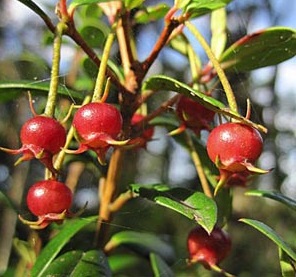
3240 Chilean Cranberry ( Ugni molinae )
Botanically its in the Myrtaceae ( Myrtle ) family and is not related to the cranberry ( which the small red berries resemble ). The delicious 3/4″ fruits have a wild strawbery taste. Although this fruit is relatively unknown to most of the civilized world it is expected to make a commercial impact in
the future. It had been introduced to England in 1844 and became a favorite fruit of Queen Victoria. The processed fruits are beginning to enter the world markets. It is a handsome shrubby tree to 7′ laden with small oval leaves, glossy and spicy scented when crushed. It develops small profuse pink
tinged blossoms which have the fragrance of strawberries. Hardy to zone 8, once established it is drought resistant and can tolerate some frost. Makes an excellant ornamental tree and may be pruned to desired height. Requires bright light and well draining acid soil.
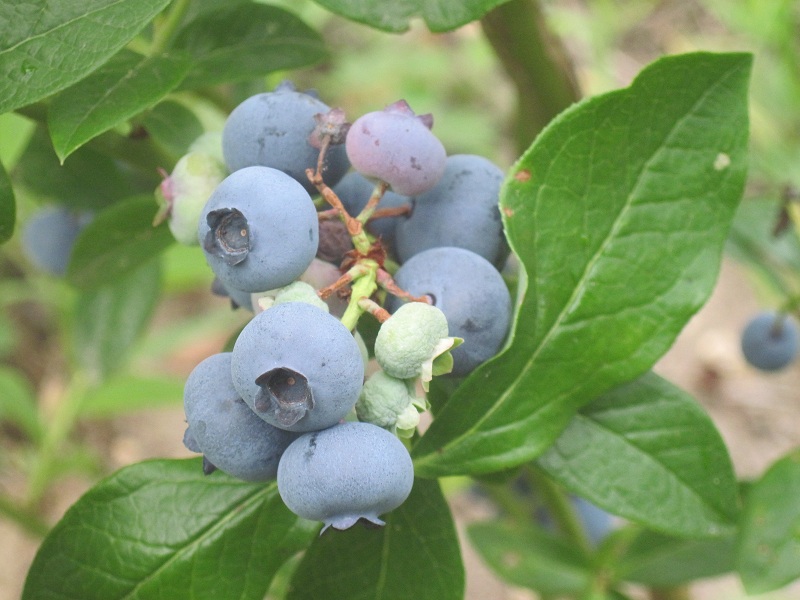
FDR97 Highbush Blueberry ( Vaccinium corymbosum )
Pre-stratified seeds need to be planted immediately upon receipt.
Germination instructions are not on seed packets, click here for germination instructions.
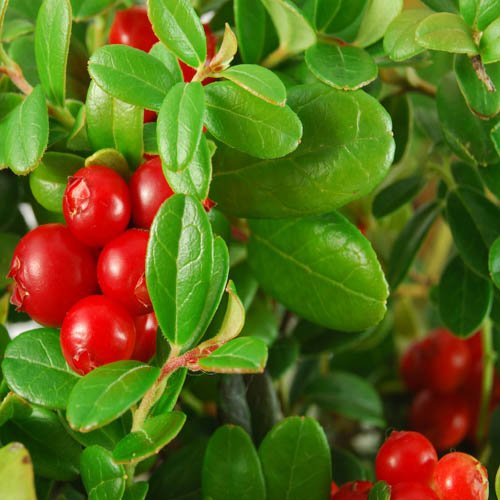
SF186 Cranberry ( Vaccinium macrocarpon )
Cranberries can be grown in-doors, in a garden, in planter boxes, raised beds, etc. Cranberries have huge health benefits and can be dry stored for extended periods of time.
Cranberries are native to North America do not need to be grown in a bog. Cranberries do require some soil preparation that is well worth the effort.
Cranberry plants can also be grown in large pots as ornamentals. These attractive, spreading plants are a unique addition to any garden.
With proper care, you can harvest berries the first year from the cranberry plants.
Zones 2-8 if grown outside.
Germination instructions: Sow at 64-71F for 2-4 weeks, move to 24-39F for 4-6 weeks, move to 41-53F for germination. Cover seeds 1/4 inch. Sowing Rate: 2 – 3 seeds per plant. Moisture: Keep seeds moist until germination.
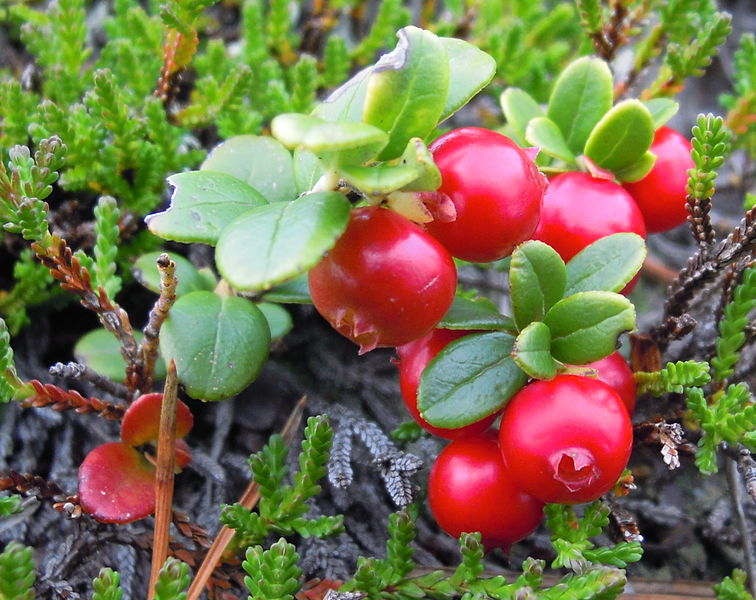
W253 Mountain Cranberry ( Vaccinium vitis-idae )
Depending on where you are at in the world, Mountain Cranberry may also be called: Lingonberry, Cowberry, Foxberry, Quailberry, Beaverberry, Red Whortleberry, Bearberry, Lowbush Cranberry, Cougarberry, Mountain Bilberry, Partridgeberry, Redberry, and more.
Mountain Cranberry is a short evergreen shrub in the heath family that bears edible fruit, native to boreal forest and Arctic tundra throughout the Northern Hemisphere from Eurasia to North America. Lingonberries are a staple in Northern Scandinavia, picked in the wild and used to accompany a variety of dishes.
Hardy for zones 2-7.
Germination instructions: Sow at soil temperuture of 41°F or lower, needs to planted in cold soil, the warming soil triggers germination, germination irregular, often several months.
Average Germ Time: 6-12 weeks. Light Required: Yes.
Depth: 1/8-1/4 inch. Sowing Rate: 4 – 5 seeds per plant.
Moisture: Keep seeds moist until germination. Plant Spacing: 18-24 inches.
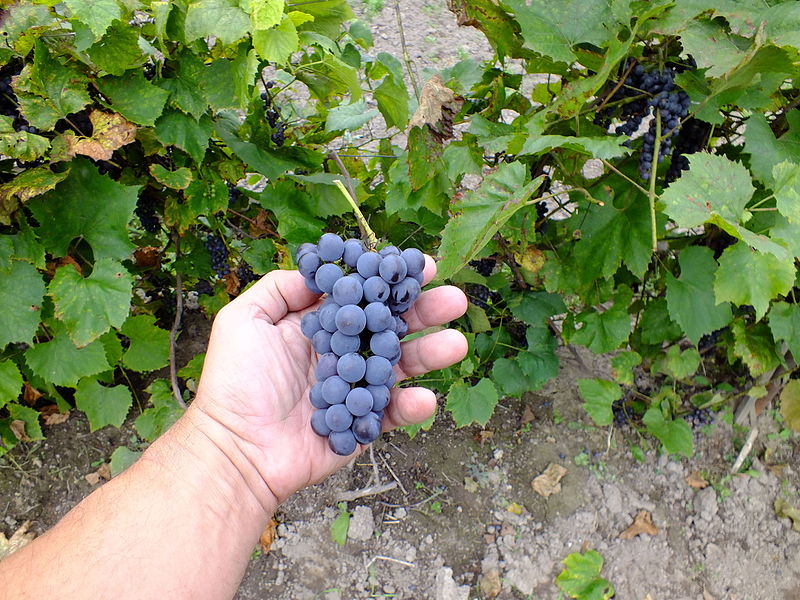
IP309 Amur Grape ( Vitis Amurensis )
This plant is suitable for growing up tall fences, arbors, and sturdy supports.A splendid and vigorous climber with reddish flossy shoots, when there young. The leaves are broad, ovate and large (3 or 5-lobed), up to 10 in. across (15-25 cm). In autumn the rather fine foliage turns a rich crimson and purple. This plant climbs by means of tendrils. This plant is attractive to bees, butterflies and/or birds.
The flowers are hermaphrodite (have both male and female organs) and are pollinated by insects. They bloom from May to July, and the seeds ripen from September to October. After the flowers the fruits appear, they are small (1-1.5 cm) colored purple to black, and they taste very good, making wonderful jelly.
Hardiness zones: 4-9. Even if it has small soil requirements, this plant prefers a deep rich moist well-drained moderately fertile loam. The plant does best in calcium rich fertile loamy evenly moist soils for best production and flavorful fruit. Vitis Amurensis succeeds in sun or partial shade; though a warm sunny position is required for the fruit to ripen. This vine is very hardy, tolerating temperatures down to about -40 degrees.
Note: These seeds need to be cold statified before
sowing.
We recommend using the Seedman’s Cold Stratification
Kits for cold stratification.
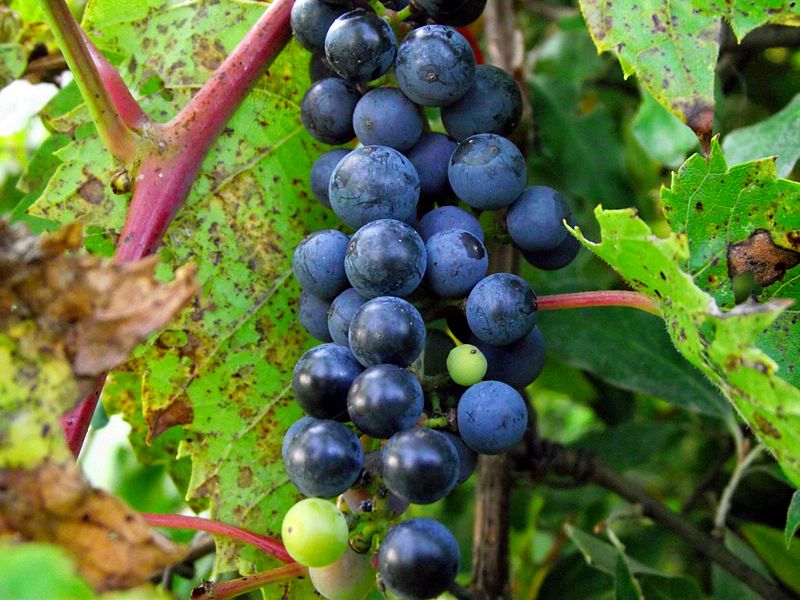
IP296 Riverbank Grape ( Vitis Riparia )
England. It is long-lived and capable of reaching into the upper canopy of the tallest trees. This plant is highly valued by wildlife and perfect for naturalizing woodland areas or along fences. This vine is a strong climber reaching 12m (2m of annual growth).
This plant is recommended for covering tall fences and various supports as well as concealing unsightly buildings. It can suppress the growth of other plants. The growth form is that of a woody vine. There are well-developed tendrils that wrap around nearby plants or other objects to help the vine climb.
Mature vines have loose, fissured bark, and may attain several inches in diameter. Leaves are alternate, and lobed (there can be dramatic differences in the lobbing pattern from one leaf to the next). The lobes are generally sharp-pointed and there are also large sharp teeth along the margin. The leaves often have opposite tendrils or inflorescences; they are about 2-10 inches long and 2-8 inches broad, sometimes with sparse hairs on the underside of veins, and are glossy green on both surfaces.
The vine has large panicles of delightfully Mignonette scented flowers, a most unusual feature, in early summer. The inflorescence is 6 inches long and is loose, and the flowers are small, fragrant, dioecious, and white or greenish in color. V. riparia blooms in May or June and produces a small 6-15 mm blue-black berry (grape) with a bloom, seeded, juicy, edible, vinous-herbaceous in flavor (not foxy), but usually sour.
Hardiness zones: 2-9. The vine is extremely cold hardy and easily survives temperatures as low as 40 degrees below zero. The riparia vine prefers a deep rich moist well-drained moderately fertile loam. This vine does best in calcium rich fertile loamy evenly moist soils for best production and flavorful fruit. It will grow best in a calcareous soil. It will succeed in sun or partial shade though a warm sunny position is required for the fruit to ripen. This is an undemanding, drought tolerant and fully hardy species.
Note: These seeds need to be cold statified before
sowing.
We recommend using the Seedman’s Cold Stratification
Kits for cold stratification.
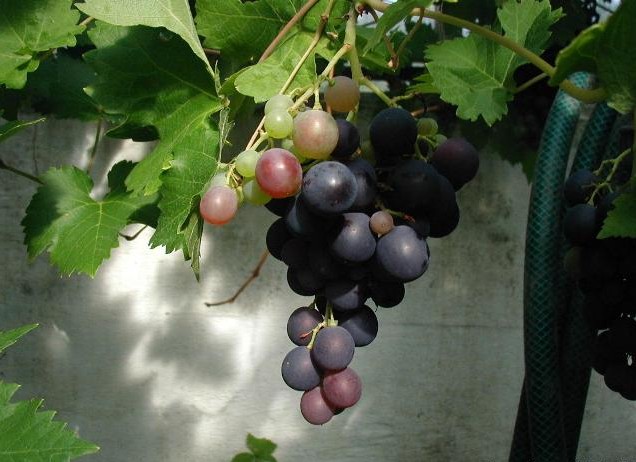
IP297 Common Wine Grape ( Vitis vinifera )
An interesting climber with green leaves covered with silvery down. This plant is ideal for color compositions with shrubs, other climbers or trees with dark leaves or flowers. The leaves are alternate, palmate and lobed, about 5-20 cm long and broad.
The flowers of the vine are of color yellow-green and are gathered in bunches. They are intensely fragrant, hermaphrodites (have both male and female organs) and are pollinated by insects. Since it has both sexes, you need only one plant to be able to enjoy the fruits. The flowers will bloom from May to July.
The sweet edible fruit is a berry, known as a grape; in the wild species it is 6 mm diameter and ripens dark purple to blackish with a pale wax bloom; in cultivated plants it is usually much larger, up to 3 cm long, and can be green, red, or purple. Fruits ripen from September to October.
Hardiness zones: 5-10. Tolerating temperatures down to about -20 degrees. Best grown in fertile, moist but permeable soil that is rich in calcium, but it will also succeed moderate soil. This vine does best in calcium rich fertile loamy evenly moist soils for best production and flavorful fruit. It likes sunny, warm and well-aerated spots. When grown in shade, the leaves turn green. It can freeze during severe winters. The species typically occurs in humid forests and stream sides.
Note: These seeds need to be cold statified before
sowing.
We recommend using the Seedman’s Cold Stratification
Kits for cold stratification.
TRN799 Banana Yucca (Yucca baccata)
A small, short trunked or often trunkless Yucca with very hard, thick, bluish, deeply concave leaves. It is widely distributed over northern Mexico and the southwestern United States and is found in mountain areas up to 7900 ft. It is extremely hardy to frost and considered to possibly being the hardiest of all trunked Yucca. Slow but easy to grow and very ornamental.
Most yuccas have dry hard fruits, but the fruits of banana yucca are fleshy and succulent. They look roughly like short fat green bananas, thus the name. These fruits were a traditional food of the Apache and Navajo. They were prepared by roasting or baking, stripping out the seeds, pounding the remaining flesh into a pulp, forming the pulp into flat cakes, and sun-drying them for later use.
The resulting product is said to be nutritious, sweet, and delicious. The fruits were often picked before maturity and ripened off the plant to keep wildlife from eating them before they could be harvested
Hardy for zones 6-11.
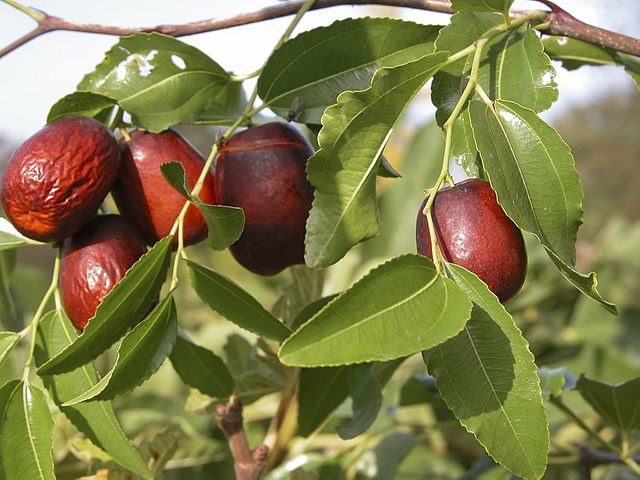
1A030 Chinese Jujube ( Zizyphus jujuba )
The tree has a weeping ornamental growth pattern. The fruits are smooth and round like an apple and can be eaten right off the tree. Very high in vitamin C. Very fragrant flowers.
Jujube grows throughout most of the southern half of North America. For best crops, the tree needs a long growing season and hot and dry weather during ripening. About the only parts of the United States where jujube can’t grow are in the North (USDA Zones 5 and colder) and the Gulf Coast where summer rain and humidity prevent optimum fruiting.

TRZ088 Inidan Jujube ( Zizyphus mauritania )
A smaller version of the Chinese Jujube, it needs zone 9 and
higher to produce fruit. A bushy, deciduous tree to 20′ with
ovate leaves. It’s 1 inch, acidic tasting fruits are used
preserved, dried, pickled, and in confections. Fragrant
flowers.
Source link

